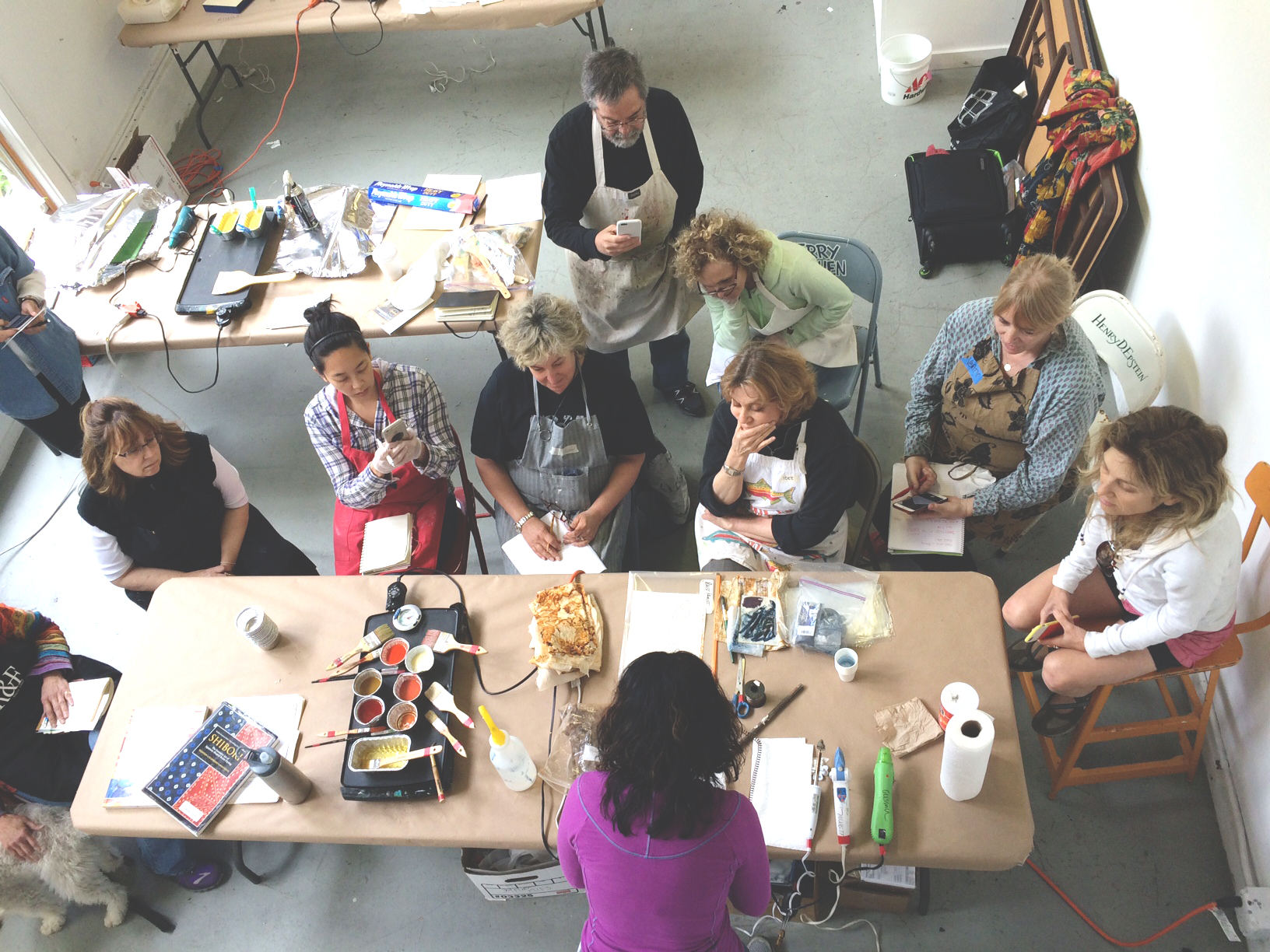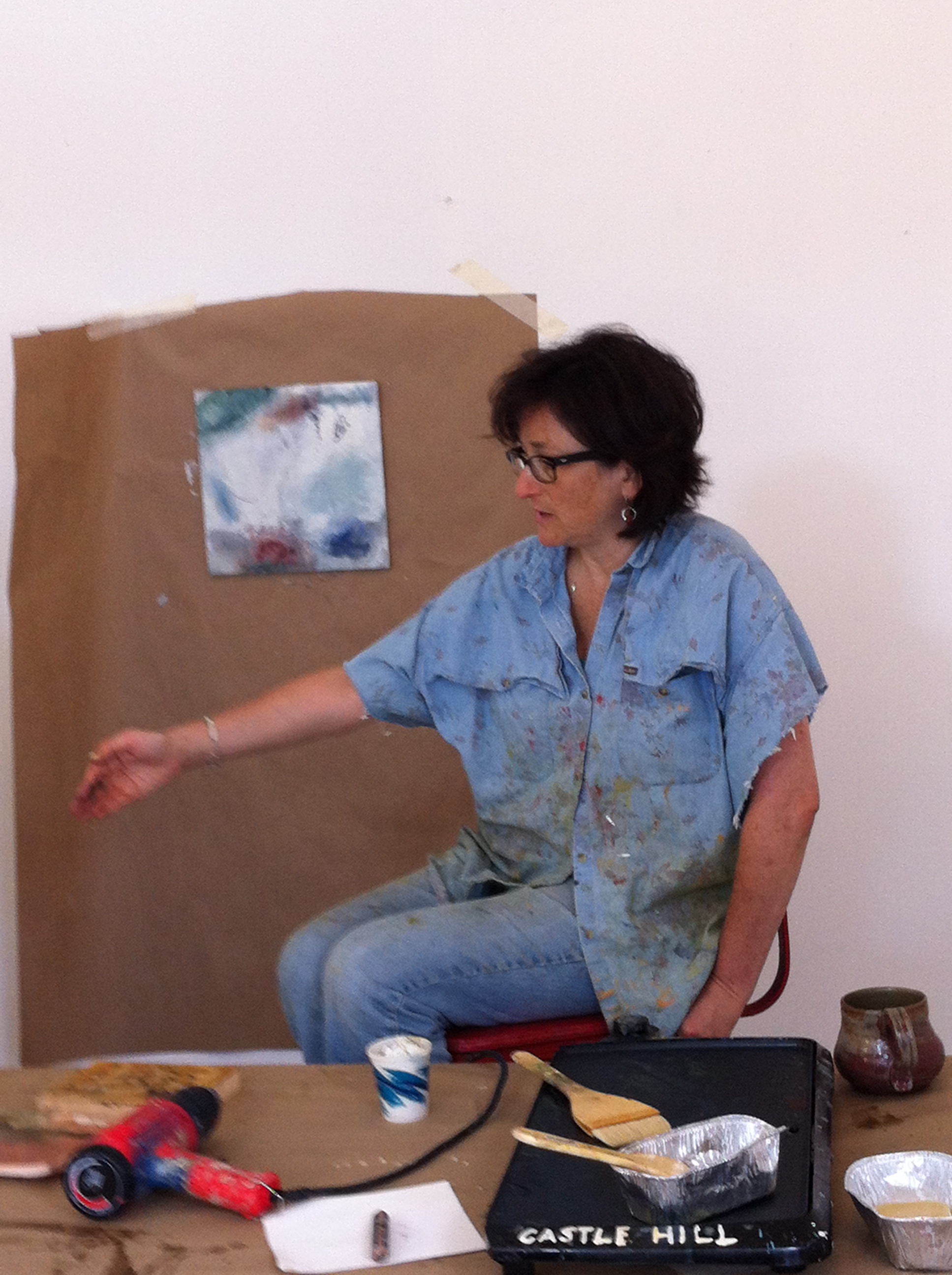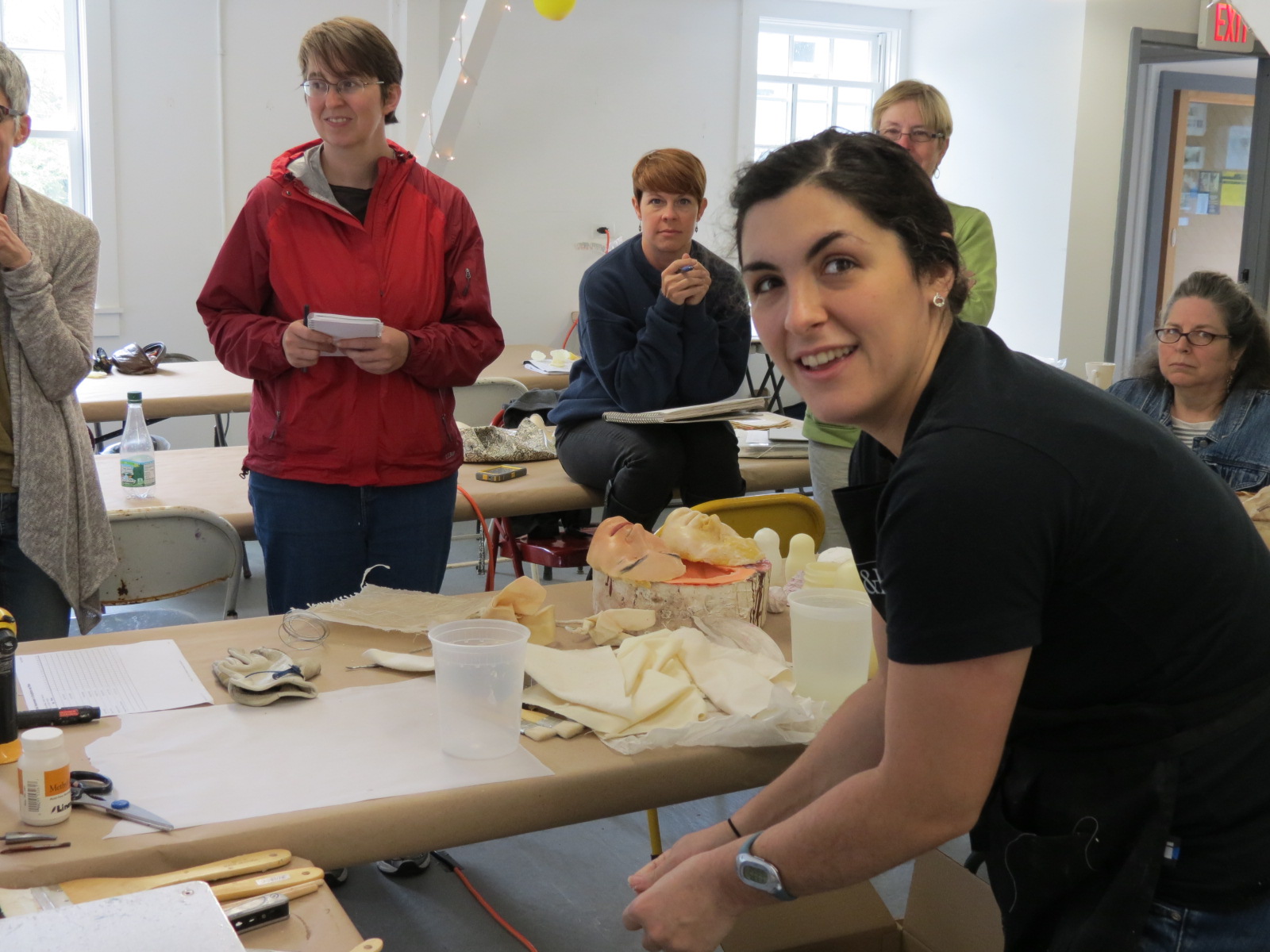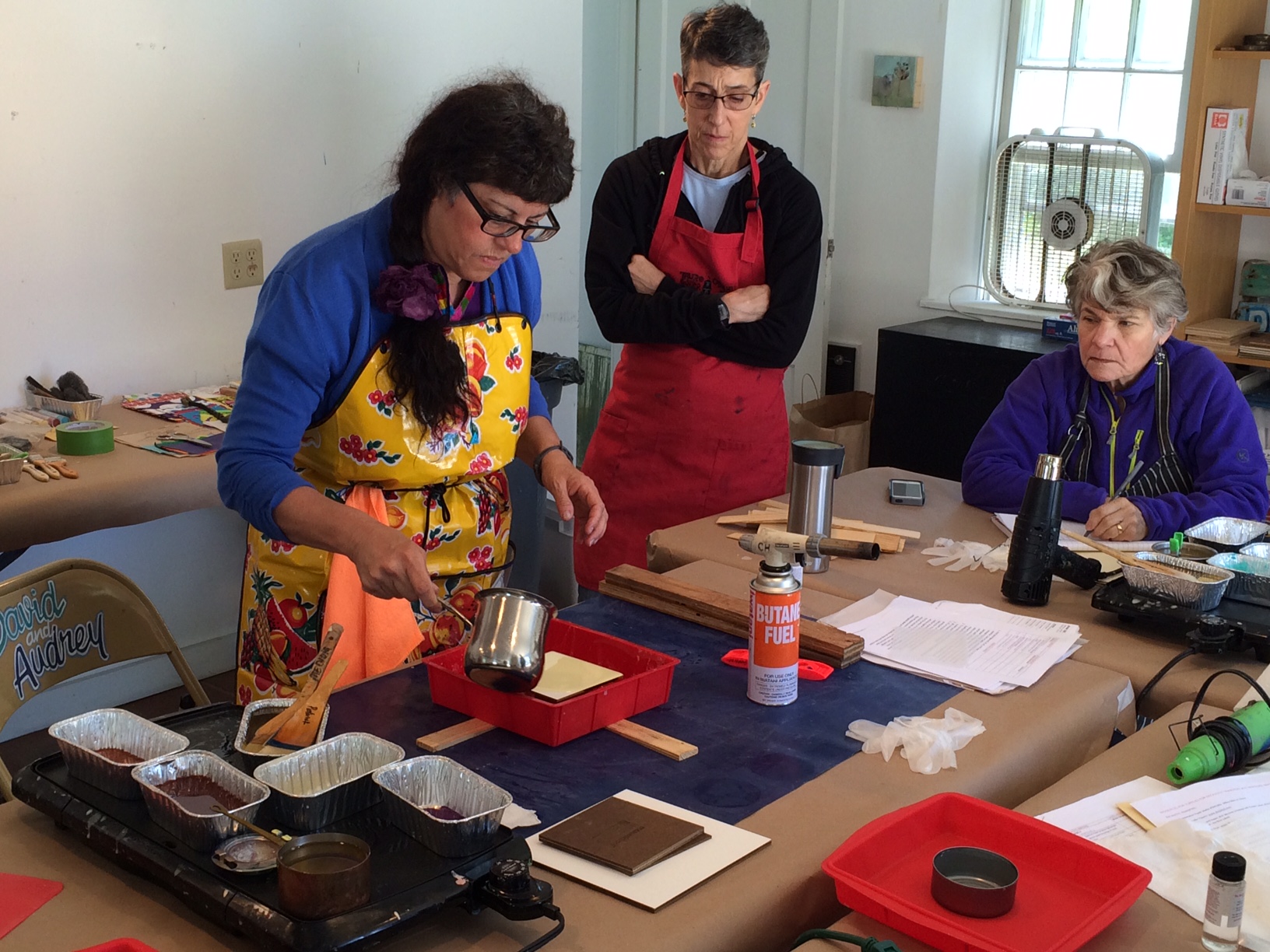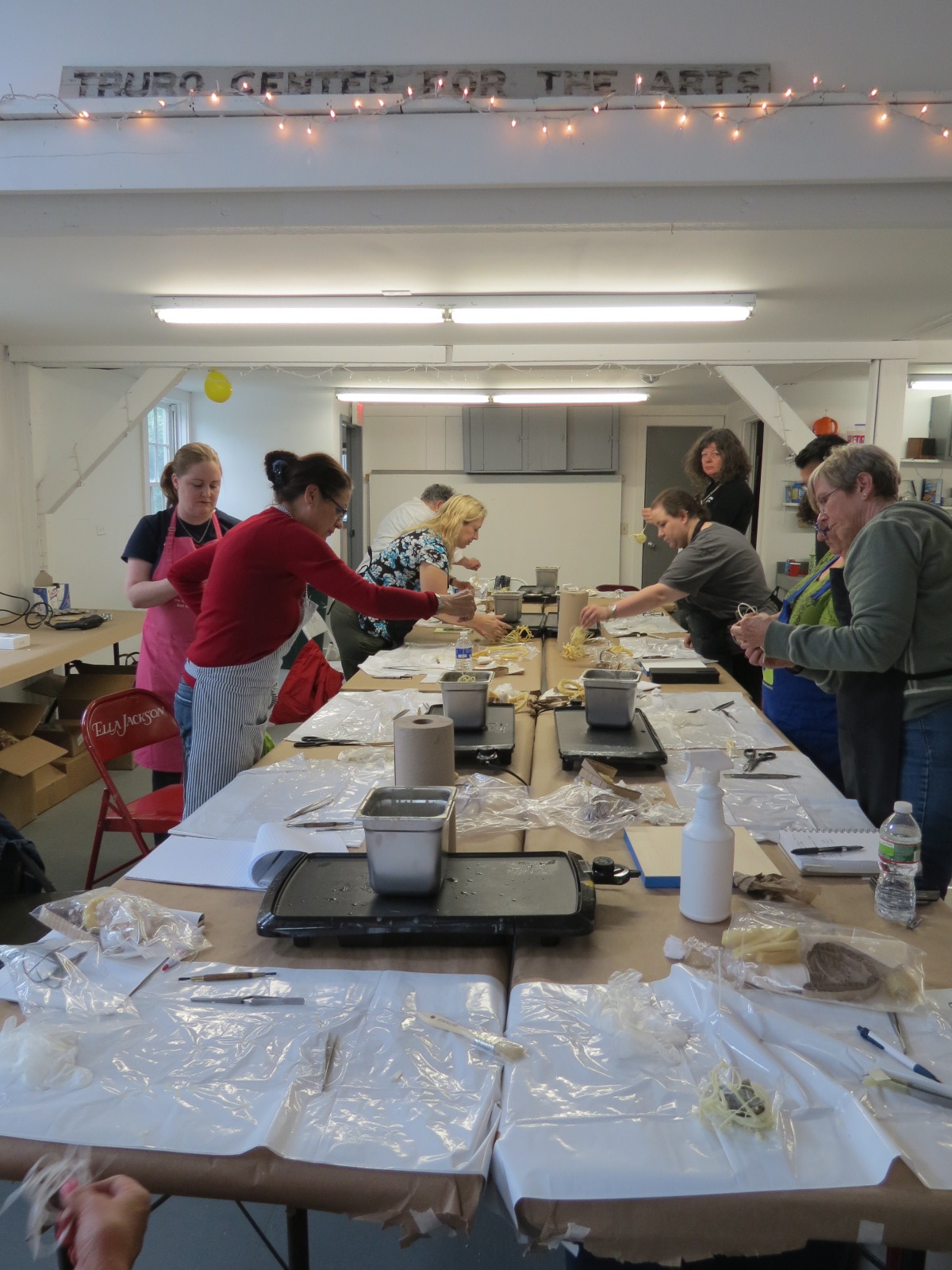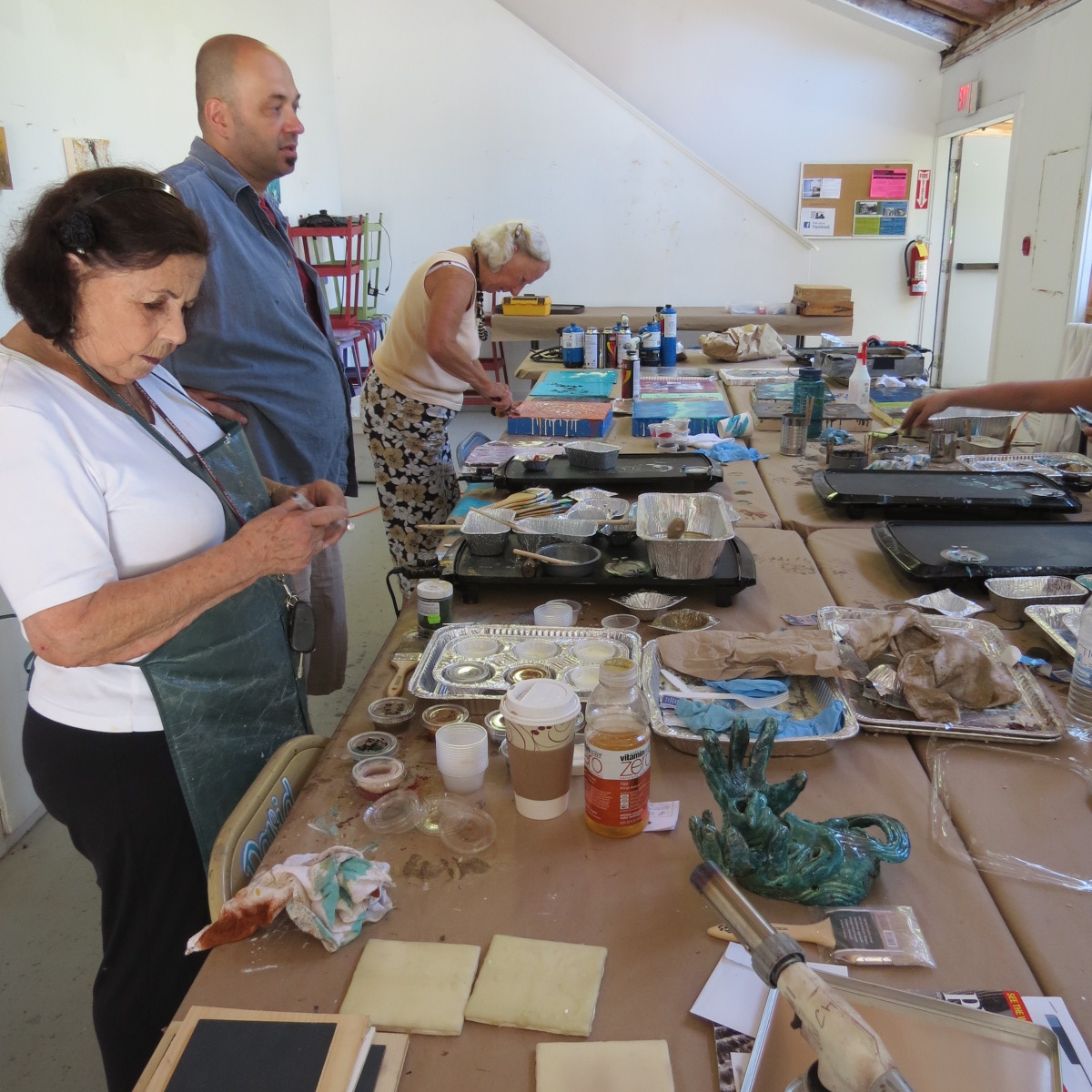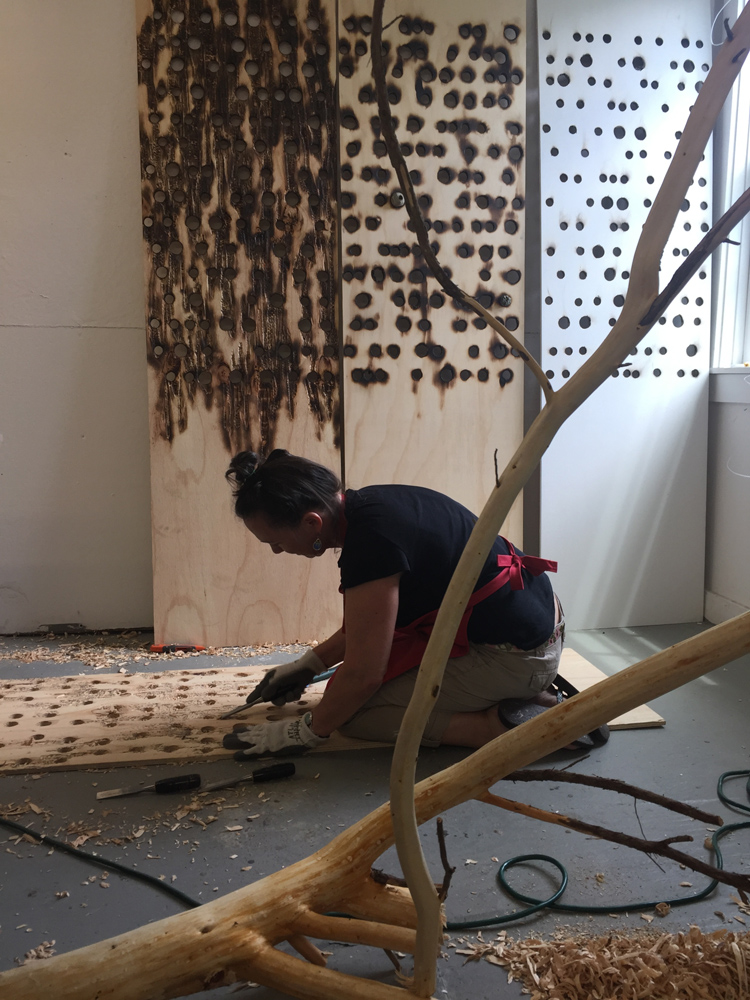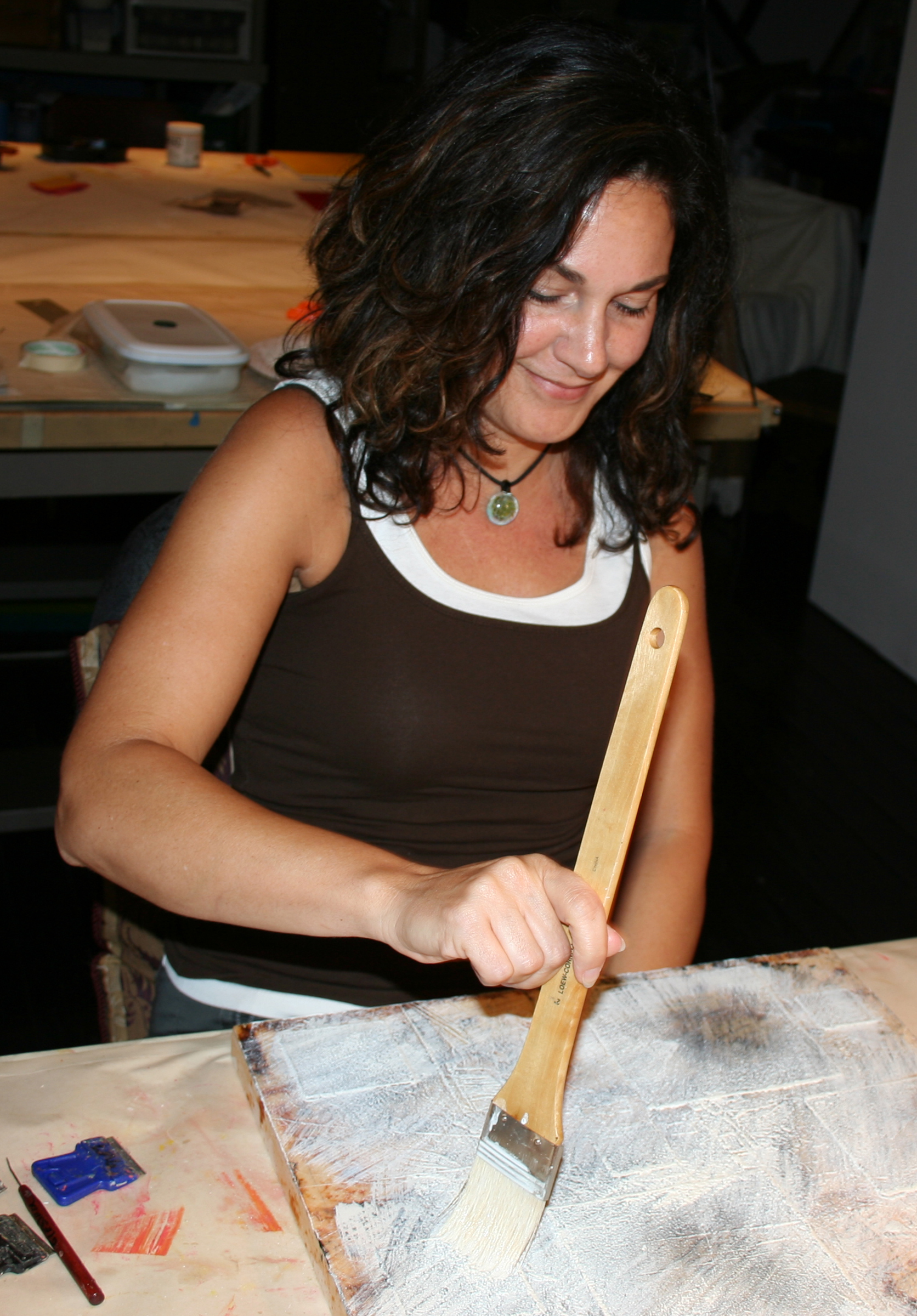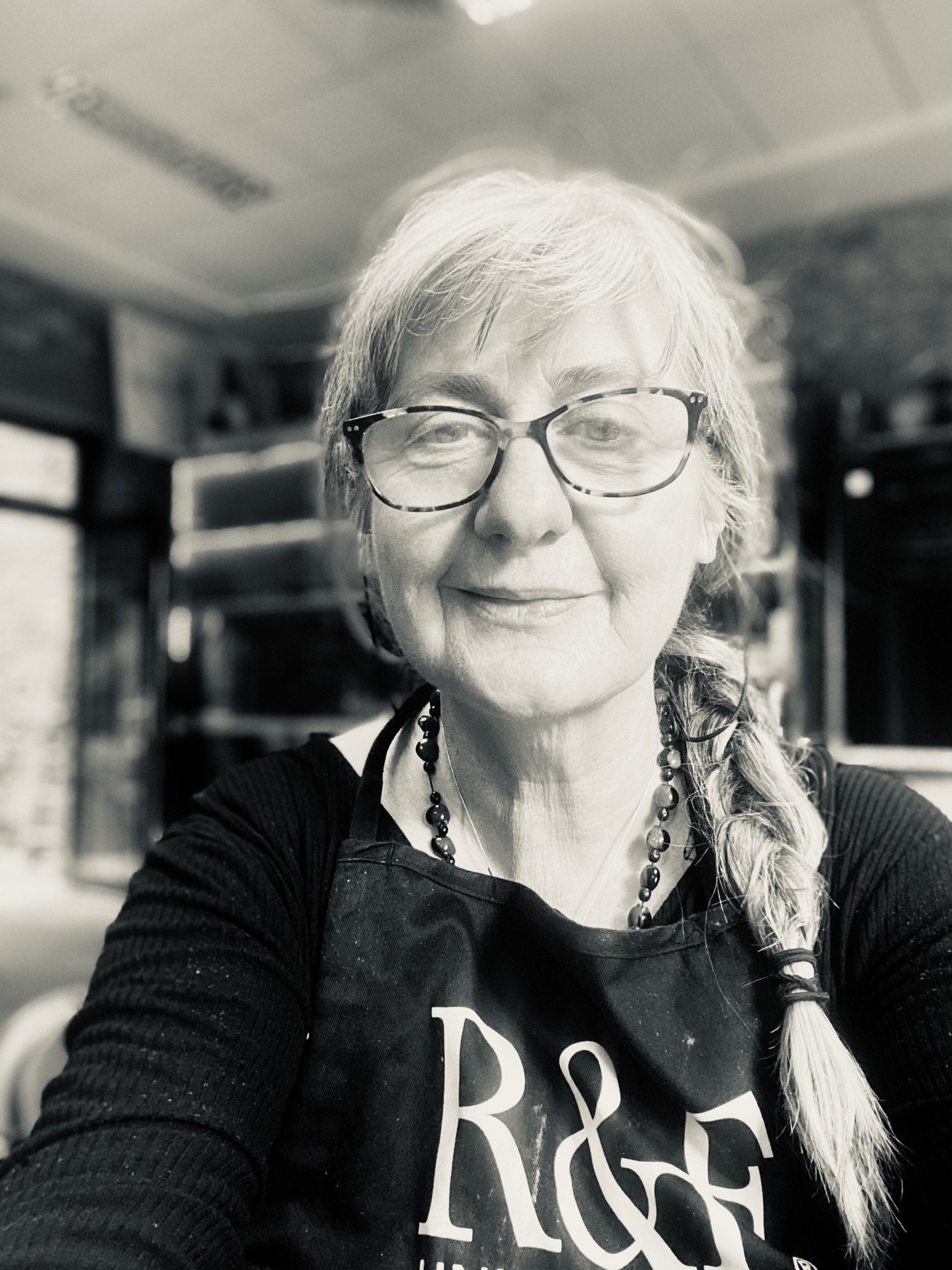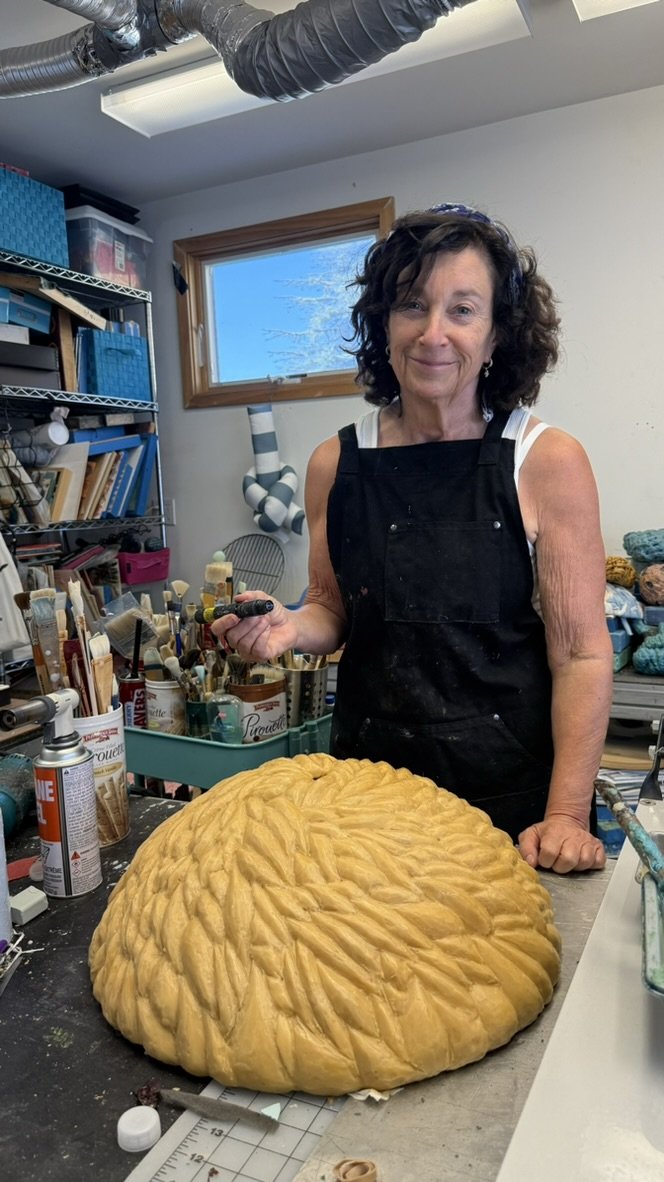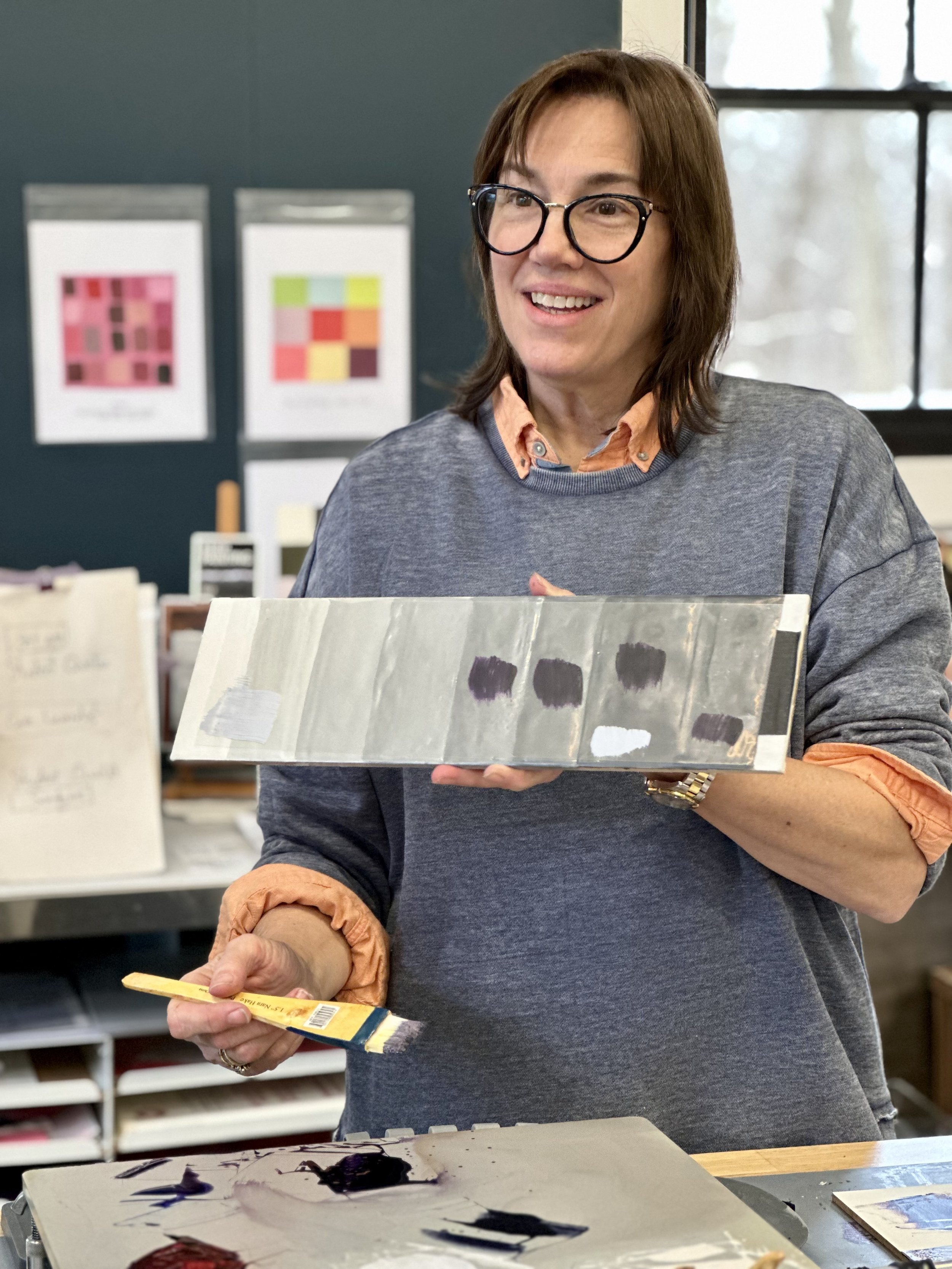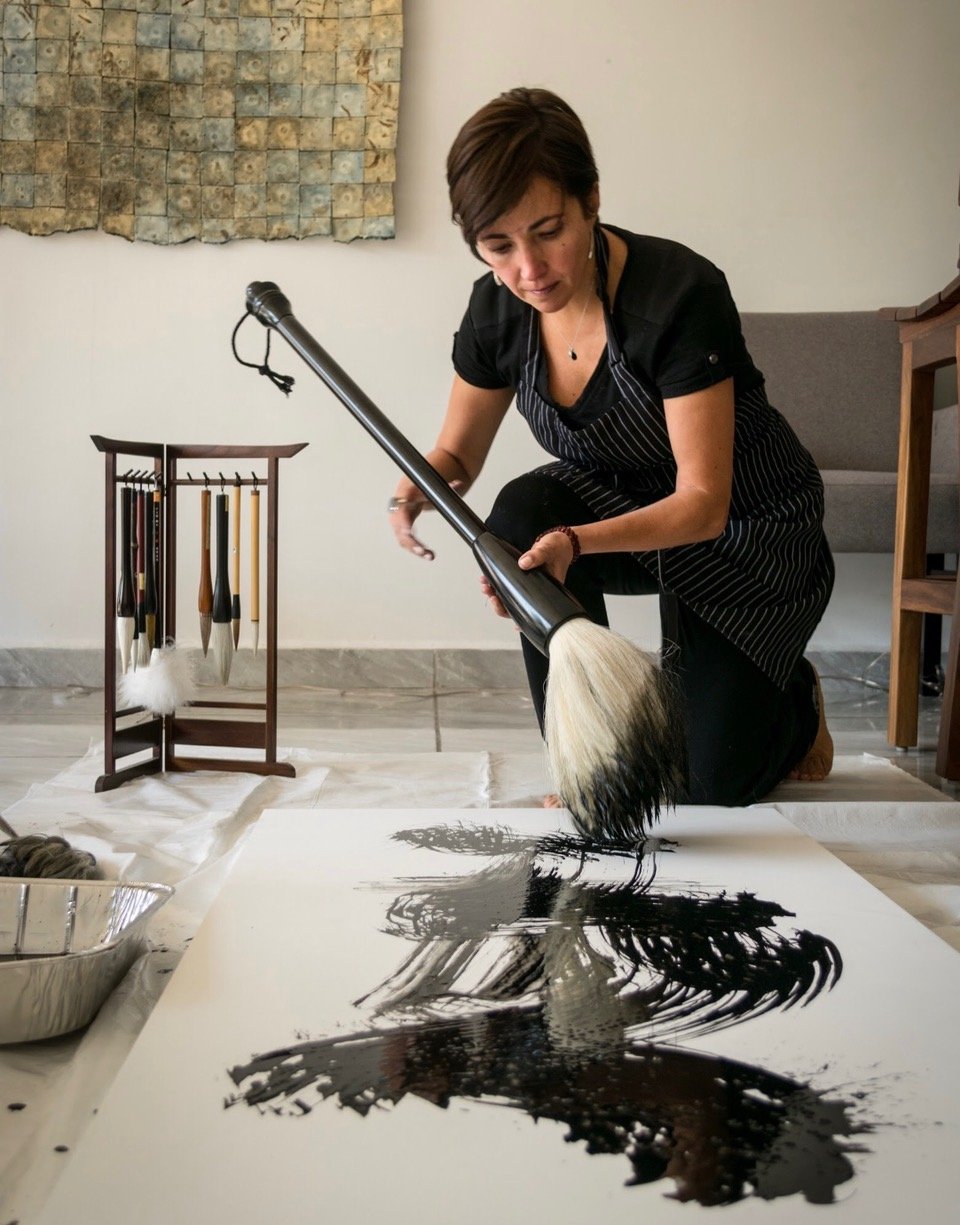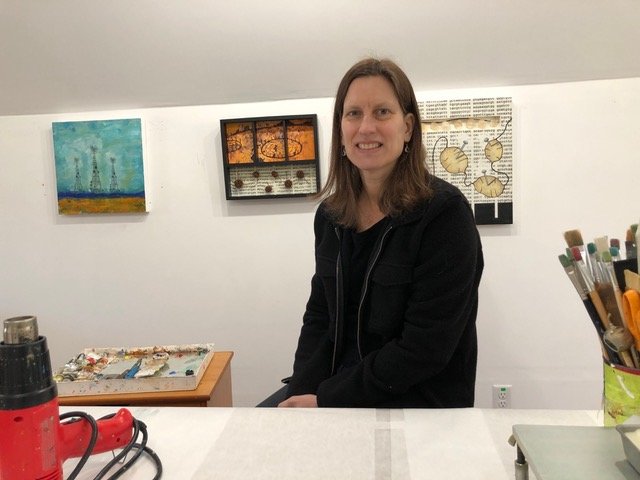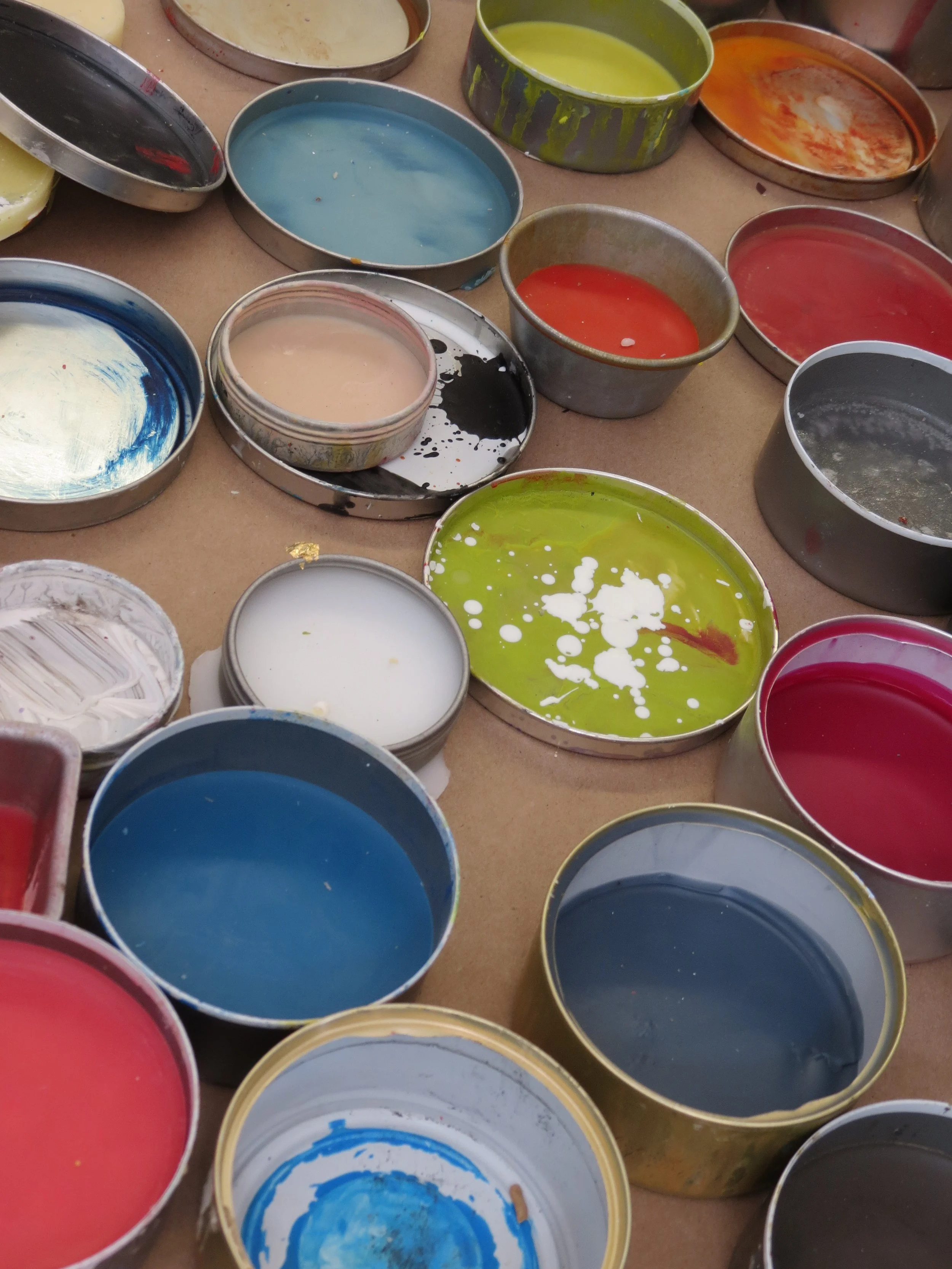
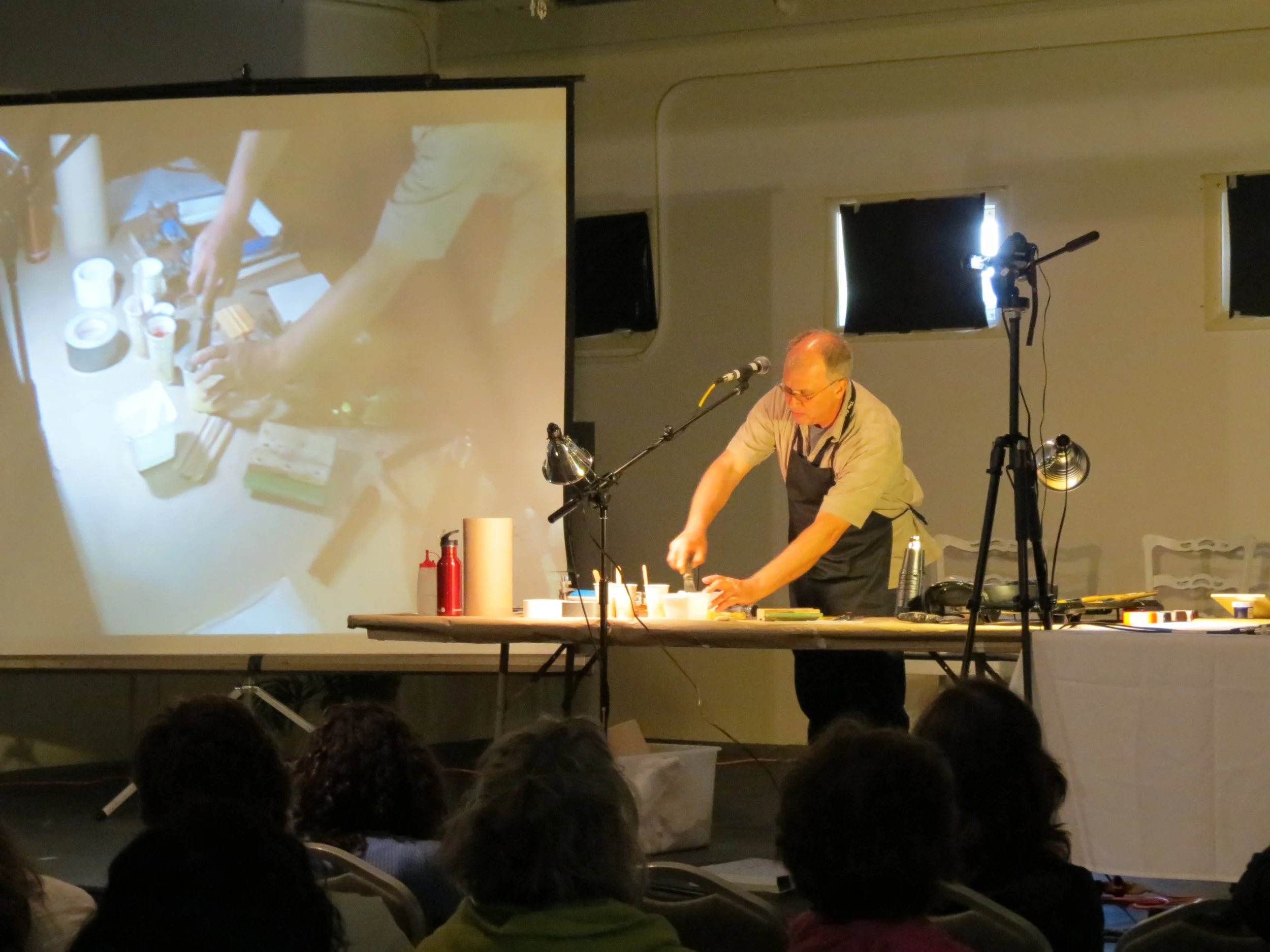


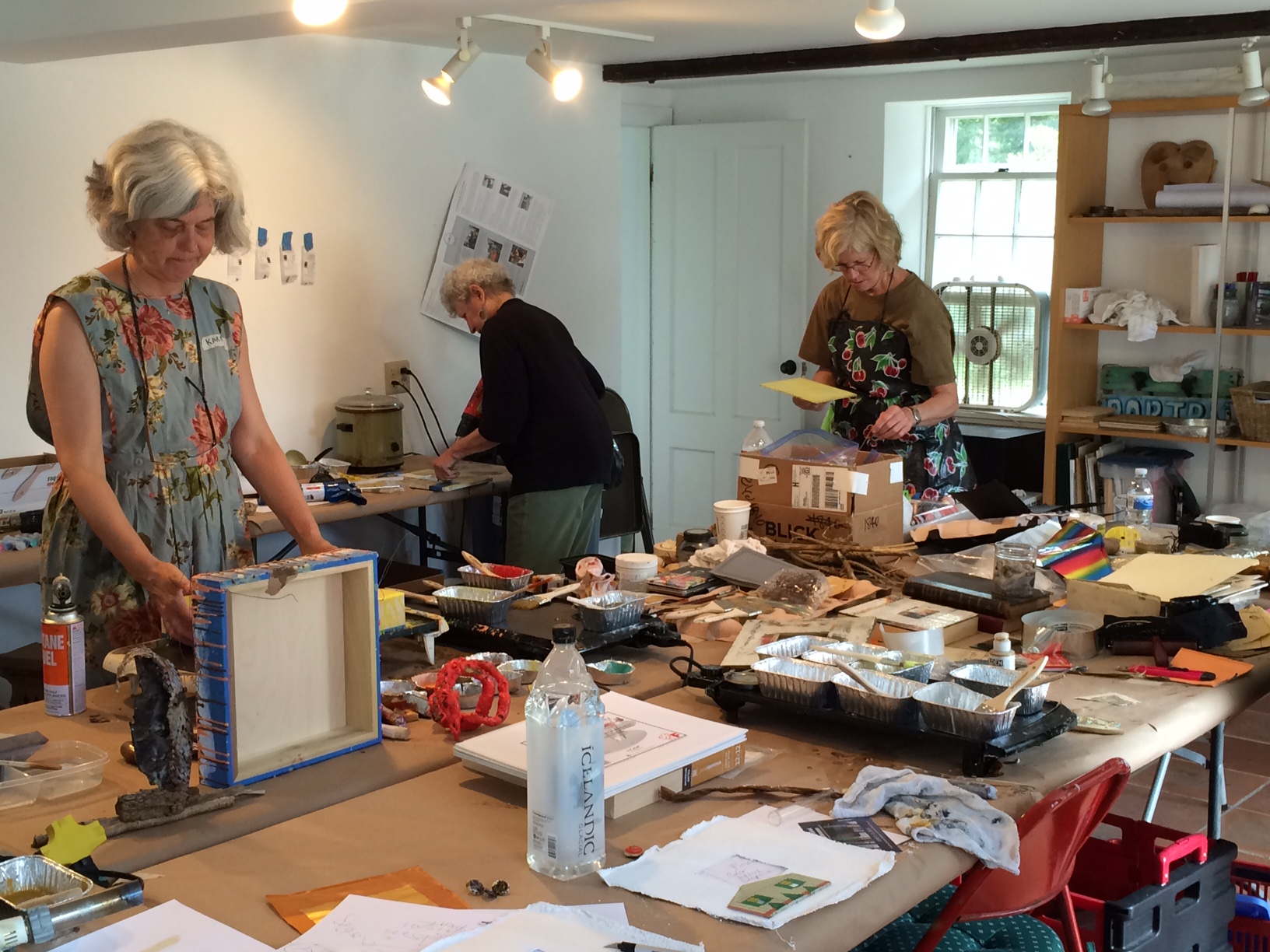

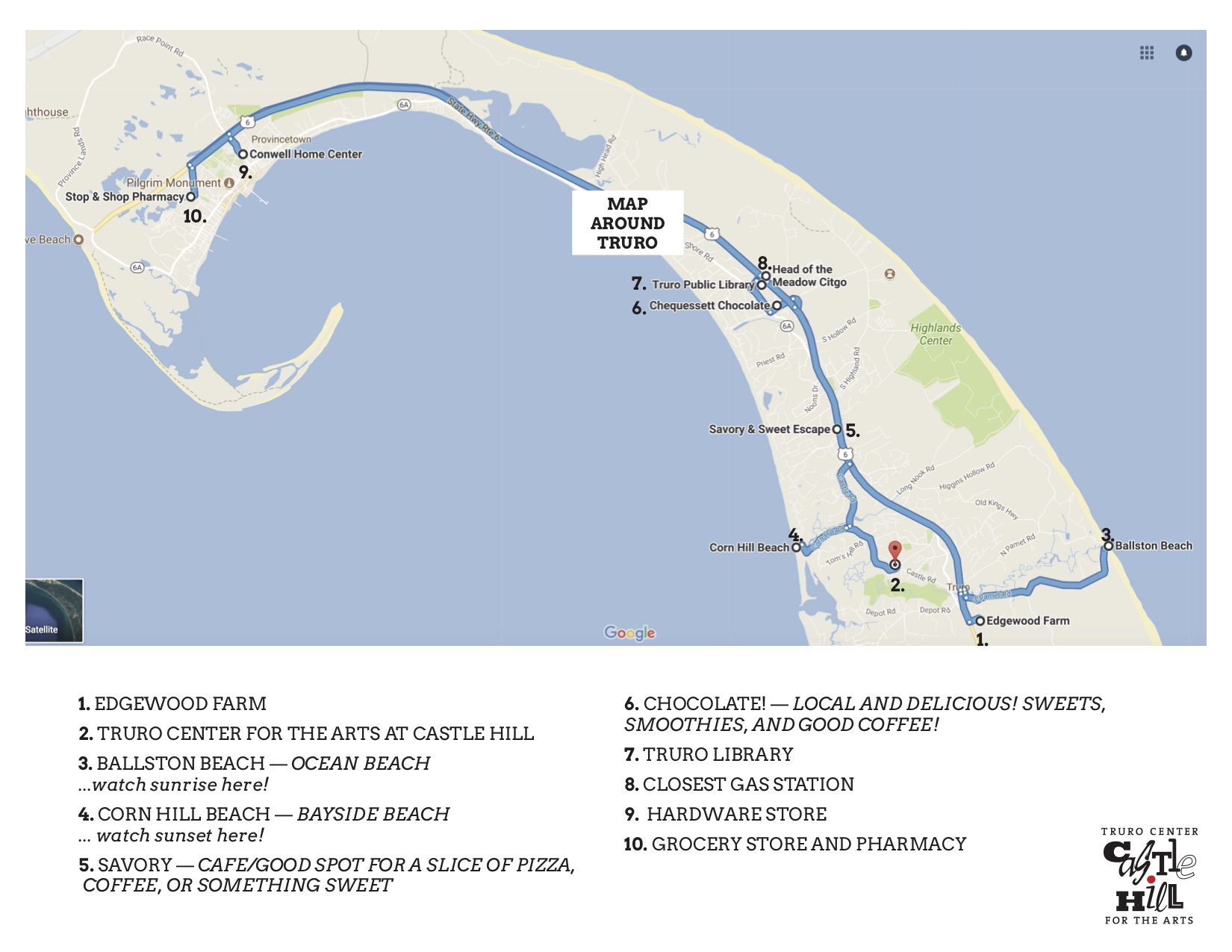
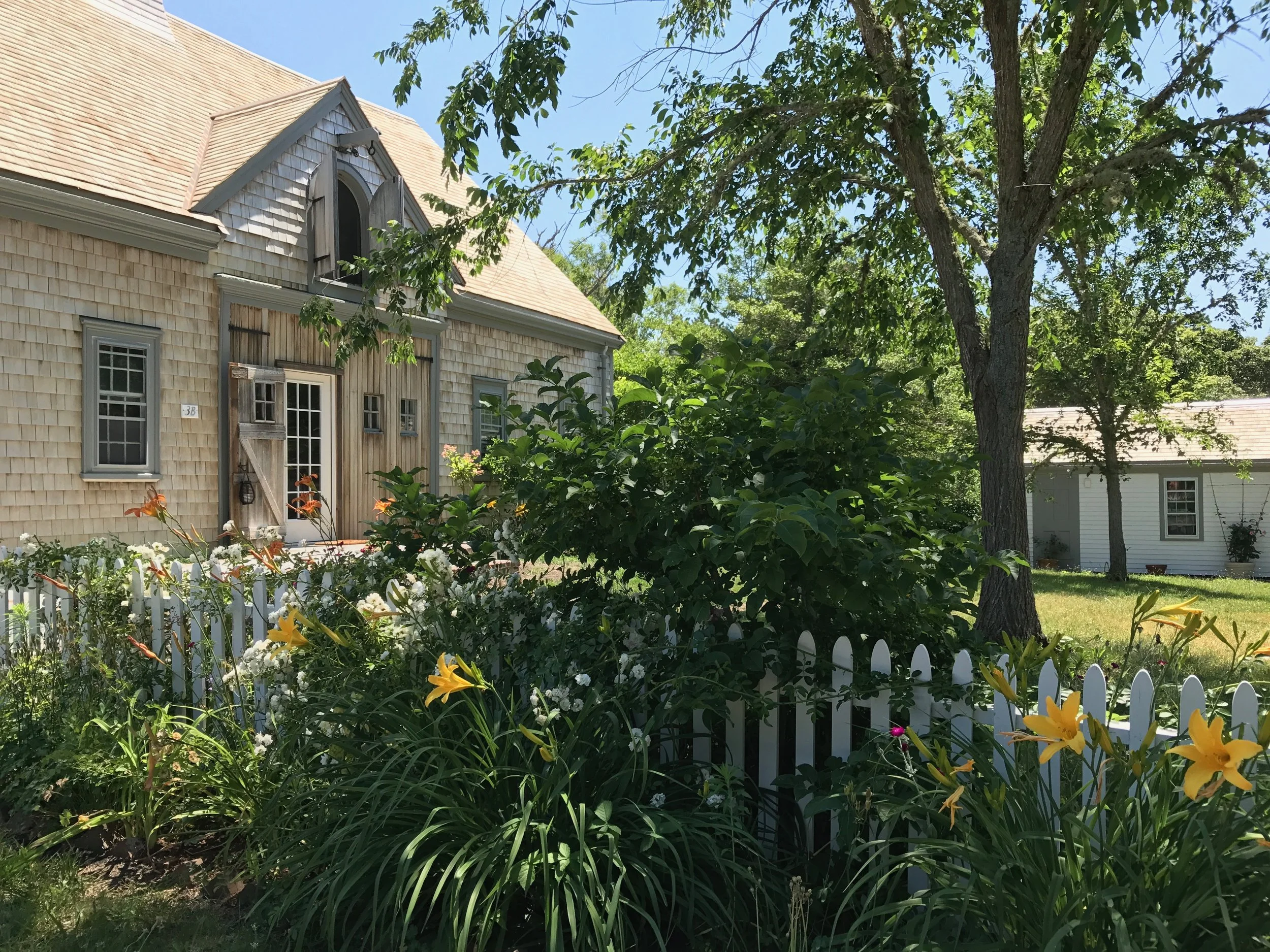

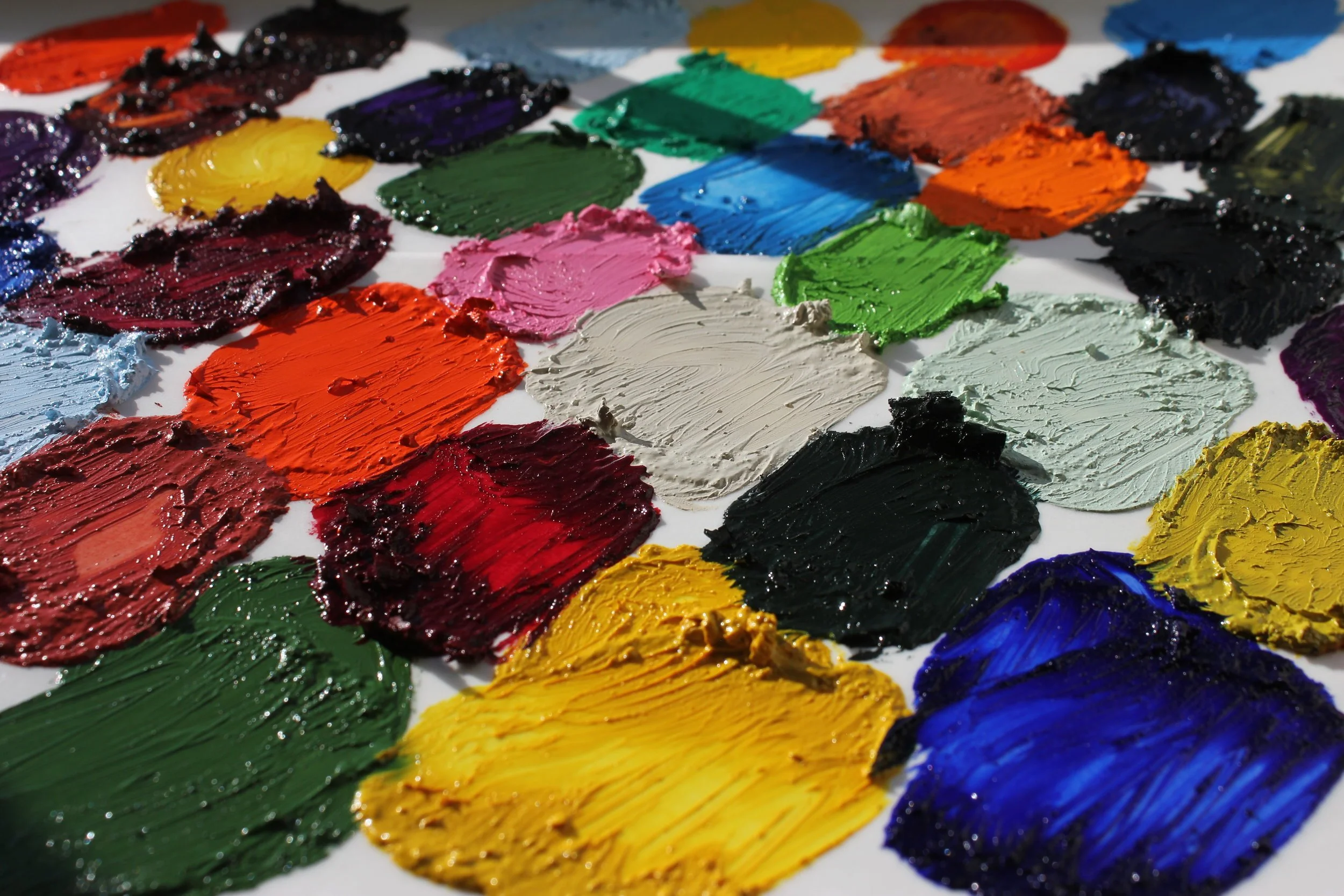
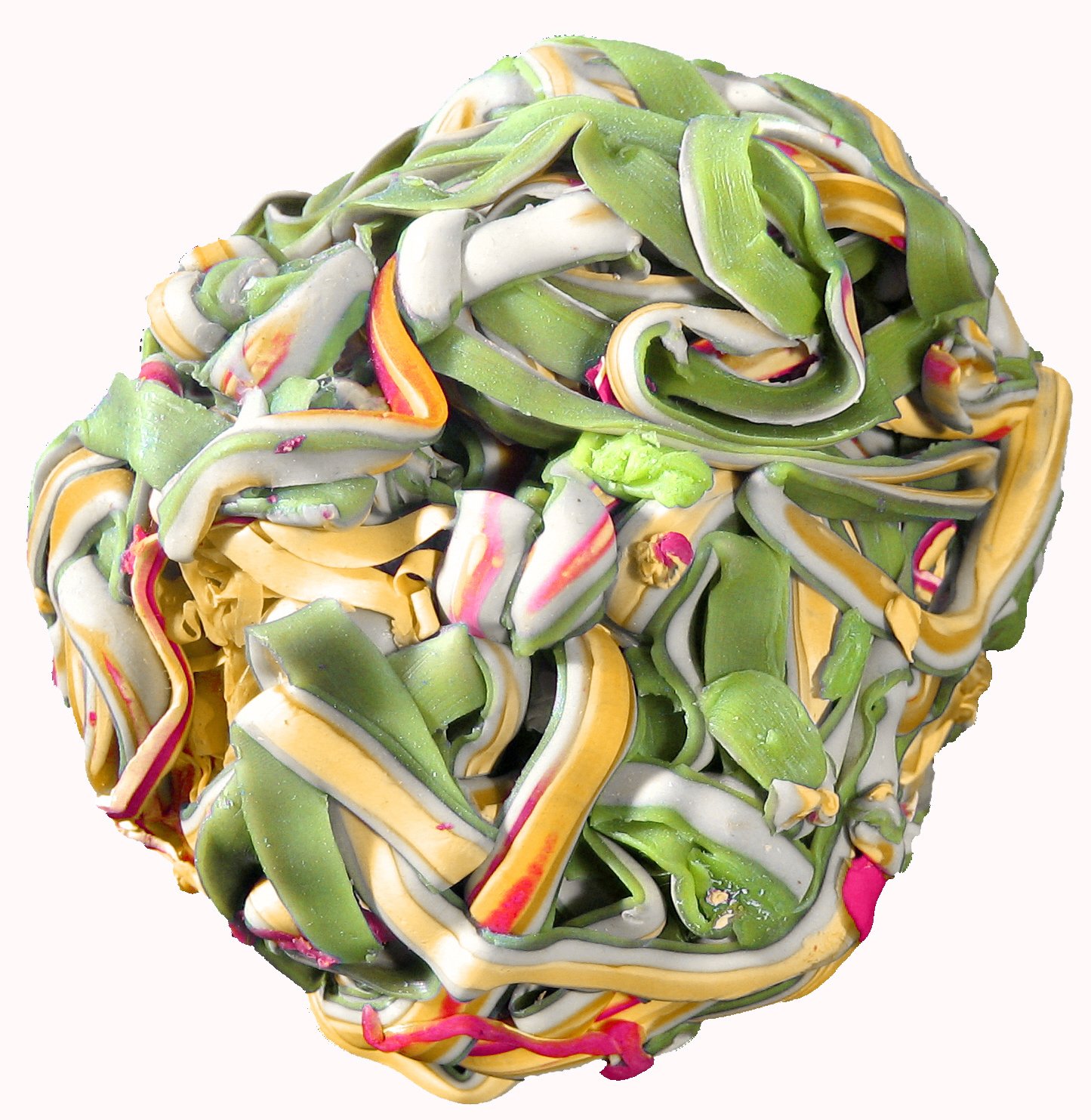



Conference Home Page
Conference Home Page
The 18th International Encaustic Conference
May 30 - June 1, 2025
Bringing a community of artists together with gallerists, curators, critics and collectors engaged with wax, printmaking, mixed media and professional practices. The 18th International Encaustic Conference is directed by Cherie Mittenthal and produced by Truro Center for the Arts at Castle Hill.
Attending this year's Conference? Want to stay in the loop?
Join the International Encaustic Conference Facebook Group to connect with fellow attendees.
Big News!
The Conference will take place at Edgewood Farm in Truro this year!
Click the links below or keep scrolling down to learn more.
Postcard Show
Sunday Sale
The Vendor Room
Shows Associated with the Conference (TBA)
Scholarship Opportunity

Schedule
Schedule
2025 Conference Schedule
FRIDAY, May 30
8:30
Registration Opens
9:30 - 10:30
DEMO: Edith Beatty
Embedding (and Pouring) “Stuff” in Encaustic Painting!
When do you embed actual objects – such as string, shells, glass, flowers, or a random shoe - into your encaustic paintings? When do you represent, abstract, or suggest images through mark making? Who has practiced these techniques over time? Do you pour wax to create a welcoming surface, or adhere them while painting? Together, we will explore these and other questions, issues, concerns, and fun in our practice.
TALK: Patti Russotti
Hunting, Gathering, and Collecting: Expanding and Strengthening Your Creative Vision
This approach is deeply connected to a daily practice and the expansion of your thought processes. It caters to individuals from all genres and disciplines who are eager to explore techniques that will enhance their studio practice. We will explore a variety of options and unveil a new realm of possibilities for merging the analog and digital worlds.
VIDEO PRESENTATION: Bettina Egli Sennhauser
10:45 - 11:15
Welcome and Orientation for Newcomers
11:30 - 12:30
DEMO: Tracy Spadafora
Getting Images Onto / Into the Surface
This demonstration will show you how to add drawings, text, photo images, organic matter, gilding foils, and much more to your encaustic creations through the processes of collage and transfer. Learn how to apply and prepare a wax surface for transfer & collage and how to layer and protect images after they are adhered. The archival characteristics of these mixed media techniques will be covered.
TALK: Kelly Milukas
Learning to See ∙ Developing Your Voice ∙ Participatory Lecture
Many are very interested in learning how to paint but sometimes may or may not be as interested in learning how to draw... But what if I told you that learning to draw would improve your painting skills significantly?! So, if you are a painter – I encourage you attend this participatory talk! No rulers, and no words like perspective or ellipses will be included! Kelly will guide you through a brief set of creative skill building exercises to bring back to your studio practice. The prompts and supporting discussion will strengthen your individual voice with new ways to experience seeing, and making lines translated to drawings with a fully engaged body and heart centered practice. Paper and Drawing Media will be Provided.
DEMO : David A. Clark
Boxes for Storing and Shipping Encaustic
This demonstration will give Conferees the skills to construct simple storage and shipping containers for their encaustic work. They will learn how to construct a basic cardboard box and then adapt that “basic box” to protect and cushion the work. Conferees will also learn how to adapt the “basic box” in order for it to function as a reusable container for shipping work to galleries and museums. I will also cover simple solutions to protect work when it is stored in the studio or in a gallery rack including constructing padded sleeves and removable “bumpers” to protect the edges and surfaces of work. Conferees will leave this demonstration with all of the basic skills needed to construct their own customized boxes, storage protection solutions and shipping containers. A handout with patterns will be provided.
12:30 - 1:30
Lunch
1:30 - 2:30
DEMO: Extreme Texture
Jodi Reeb
Are you ready to push your work to new heights? I will show you how to create deeply textured and layered paintings, embedding objects and carving the surface. You will learn many accretion techniques using recycled materials as collage as well as excavating paint layers with clay tools.
TALK: Susan Lasch Krevitt
2025 Conference Presenters and Workshop Instructors
This slide presentation features the work of the Conference Presenters and Workshop Instructors at The 18th International Encaustic Conference in 2025. No one gets to see ALL the demos or take all the workshops! So much Encaustic, so many ways to use it!
TALK: Debra Claffey
Encaustic Collage: A Survey Who’s Doing What? What’s Been Done and What’s New?
What’s new in encaustic collage? Who has taken it to someplace new? This talk will inspire you to revisit tried and true techniques for new ideas and direction for your work.
2:30 - 3:00
Break
3:00 - 4:30
ROUND TABLE: David A. Clark, Milisa Galazzi
Ask Anything: A Deep Dive into Being a Working Artist
"I have no more room - How do I find and set up a studio? I want to sell my art - How do I get my work into a gallery? This art thing is expensive - How do I make ends meet? I have so much going on with my family and my life - How do I juggle being an artist with everything else going on? I am not even sure what my art career can be - How do I define success and carve a career out of my passion?" These and many more questions will be discussed in this new roundtable format. David, Milisa and Lisa will lead and engage participants in a lively conversation. These three veteran artists have over 100 collective years of art making experience! They will create a brave space where they will pull back the veil of artists' secrets and discuss the joys, the challenges, and everything in between, of being an artist at any career stage. This newly created roundtable discussion is designed for veteran as well as first-time conference attendees. A robust conversation full of myriad take-aways is guaranteed!
5:30
Last call at the Vendor Room
SATURDAY, May 31
9:00
Late Registration, Vendor Room Open
9:30 - 11:30
Keynote Lecture: Esperanza Cortés
11:30 - 1:00
Break / Lunch
1:00 - 2:00
DEMO: Isabelle Gaborit
Encaustic Painting – Layers of Time and Process
This demonstration will delve into additive and subtractive techniques used in encaustic painting, focusing on how the layering of pigmented encaustic medium can create richly textured and tactile surfaces. Attendees will be guided through each step of the process, from applying heated encaustic medium and pigments to manipulating the surface through scraping, carving, and scoring. The demonstration will draw connections between the artistic process and geological transformations, showing how layers are constructed, eroded, and reshaped over time. Participants will experience how the physicality of encaustic painting mimics natural forces like erosion and decay, while also revealing textures and patterns inspired by the landscape. The goal of this demonstration is for attendees to gain a deeper understanding of encaustic painting’s unique characteristics, learning how to use its layering potential to create dynamic, multidimensional works. This session will appeal to artists seeking to explore encaustic's tactile qualities and its ability to evoke a sense of time, place, and transformation.
TALK: Joanne Mattera
Ask Me Anything
In a structured conference with slide talks and demos, sometimes you just want a nice easy session when you can talk about whatever interests you without committing to an entire hour of one topic. This will be an informal 90 minutes of questions, answers, and conversation—whether it’s about encaustic specifically or art in general, or whether you’re curious about changes in the gallery world over the past few years, how much to promote yourself, how to find a mentor, or you just want to sit back and listen in. No charts, graphs, slides. Just talk. I’ve done a lot in the past 50 years of making, showing, curating, and writing about art, and I’m happy to share what I’ve learned. But your questions will drive the hour.
DEMO: Milisa Galazzi & Sheryl Jaffe
VISUAL Q&A: Why Paper and Encaustic
2:00 - 2:30
Break
2:30 - 3:30
DEMO: Karen Bright
Beyond the Cradle! (Alternative substrates)
There are many ways to apply encaustic materials beyond the conventional cradled birch panel. This demo will include layering hot to cold applications on paper, creating alternative surfaces on wood with prepared boards (plaster, fresco, encaustic), and also demonstrate techniques in applying paint to three-dimensional surfaces.
TALK: Gabriela Sánchez
Bridging Art and Technology: Mastering Social Media and Digital Content for Artists
In this session, I will focus on how artists can effectively use tools like artificial intelligence, design software, video and music editing apps, as well as social media platforms like Instagram and Facebook to enhance their online presence. These are tools I use in my own practice, and I’ll share practical tips on how to integrate them into a successful digital strategy.
TALK: Patricia Miranda
The Ecstatic Possibility of the Studio
What does it mean to make art in a time of turmoil? Can objects resonate beyond an artist’s private experience? Where and how can notions of the ecstatic be located in the studio and the work? In light of social, political, and ecological change, tools are needed to envision art that can meet this moment, from intimate to global. If art is the expression of an individual experience of being in a body- and an act of empathy, can the studio become a space of transformation for artists and for the world? This talk/discussion will explore examples and strategies to strip away the unessential, and find ways to make work that is as urgent, honest, and close to the heart as possible.
3:30 - 4:30
Booksigning
Postcard Show Sale Opens

Keynote
Keynote
Esperanza Cortés is a Colombian born multidisciplinary artist based in New York City. Cortés’ passion for the mosaic of the Americas, its folk art traditions, rituals, music, dance and their ever evolving changes are at the core of her sculptures, paintings, installations, site-specific projects and interventions. Her artwork examines the extent to which a consciousness—national or personal—defines itself through the opposing force of transcultural experiences. The work is poetically and intricately crafted to encourage the viewer to reconsider social and historical narratives, especially when dealing with Colonialism, and raises critical questions about the politics of erasure and exclusion.
As a former Afro-Latin dancer, her work seeks to underscore and use sacred space, the patterns of dance, music and fragments of histories as departure points to investigate and build the structure and space of the installations.
Cortés has exhibited in solo and group exhibitions in venues including Smack Mellon Gallery, Bronx Museum of Art, Queens Museum, El Museo del Barrio, MoMA PS1 and Socrates Sculpture Park in NYC. National exhibitions include Albright-Knox Gallery, Ogden Contemporary Arts, Turchin Center for The Visual Arts, Jonathan Ferrara Gallery, Corcoran Gallery of Art, Neuberger Museum of Art, and the Cleveland Art Museum. She has been part of international exhibitions in Germany, Hungary, Slovakia, Poland, Japan, Mexico, Colombia, Dominican Republic, Spain and Greece.
Cortés’ awards include: New York State Council on the Arts Project Grant, Shortlist 2022 Creative Capital, John Simon Guggenheim, Hispanic Society Museum and Library Artist Research Fellowship, BRIC Media Arts Fellowship, Lower Manhattan Cultural Council Grant, Joan Mitchell Foundation Painters & Sculptors Grant, Puffin Foundation Grant, New York State Biennial, Robert Rauschenberg Foundation, New York Foundation for the Arts and the Sustained Achievement in the Visual Arts Award.
Cortés’ residencies include: Pine Meadow Ranch Center for Art and Agriculture, Ucross, Peter’s Valley School of Craft, Children’s Museum of Manhattan, McColl Center for Arts + Innovation, Museum of Arts and Design, BRIC Workspace, Joan Mitchell Center, Webb School of Knoxville, Sculpture Space, Fountainhead Residency, Bronx Museum - AIM Program, MoMA PS1 Residency, Socrates Sculpture Park, Abrons Art Center, Longwood Art Project, Altos de Chavon, Can Serrat and Bielska BWA Gallery.
Cortés’ work has been reviewed by Artforum, Artnews, Artnet, Hyperallergic, ARTFUSE, Cultbytes, New York Times, BELatina, Whitehot, New Art Examiner and Art in America. International reviews include multiple media platforms in Europe, South America and the Caribbean.
Cortés has designed programs as a museum educator, artist in residence, and community artist creating legacy projects, murals, sculptures, site-specific installations and Afro-Latin Dance, working with children, teens, elders, homeless and refugee communities, through the Lower Manhattan Cultural Council, Artist Space, Smack Mellon Gallery, Brooklyn’s Children's Museum, El Museo del Barrio, Wave Hill, Museum of Modern Art, Whitney Museum of Art, and the Museum of Art and Design.
Cortés’ work is in private and public collections, including the Museum of Fine Arts, Boston and the American Embassy in Monterey, Mexico.
CORAZÓNCITO
2022, ceramic sculpture, crystal beads, vintage crystals,
personal embroidery, encaustic on wood, 15” x 15” x 2.5”
EL ÁBOL DE LA VIDA
2023, ceramic sculpture, crystal beads, glass beads, personal embroidery, encaustic on wood, 31.5” x 23.5” x 2.5”

Pre and Post Conference Workshops
Pre and Post Conference Workshops
Pre- & Post- Conference Workshops
Expand on the topics and techniques that are presented at the Conference, learn something new, or dive deeper into your practice!
Please note that we have 2 campuses that host workshops, Edgewood Farm and Castle Hill. Materials may be included in the class tuition, you may be asked to bring other materials with you. Refer to the class materials lists for more information regarding supplies and location of each class.

Bios
Bios
Presenter and Instructor Bios
Edith Beatty maintains a studio in the village of Waterbury, Vermont. An artist most all of her life, she concentrates now on painting with oil and wax, expanding her array of surfaces, pigments, and design. Edie was born in Boston and has lived predominantly in the Northeast. She earned a Doctorate in Educational Leadership and Policy Studies from Indiana University, and enjoyed an extensive career designing and leading programs to promote social justice and equity. She now shifts her focus to making works of art that convey that same struggle and hope. Continuing her lifelong quest for learning through relationships and dialog with artists, cadres, and friends, Edie is part of the Yellow Chair Salon based in New York City, a proud member of New England Wax, and more informally, two exhibiting groups - Wax Women and BADASS Painters. She has studied with fiber, design, and encaustic artists over a period of more than 30 years, and has completed residencies and master classes at Haystack School of Craft, Crow Barn, Fuller Craft Museum, Schoodic Institute, Maine Coast Encaustic Retreat, and Truro Center for the Arts. She has shown her work through curated and juried shows throughout Vermont, New England, and nationally. Her work showed spring and summer of 2023 at M David & Co Gallery in Brooklyn, NY, Cove Street Arts in Portland, ME, Southern Vermont Arts Center in Manchester VT, and the juried show at the 16th International Encaustic Conference in Provincetown, MA. Fall and winter pieces were exhibited at Axels Gallery and the Current. Now in 2024 her work hangs in the Southern Vermont Arts Center, and the Kathryn Schwartz Gallery in Cambridge MA. Edie lives with her husband, nestled into the Green Mountains of Vermont. There they enjoy inspiring views of the mountains, woods, and continual shifts in skies and weather patterns. When not painting, she cycles, kayaks, travels, cooks, and practices yoga and meditation.
Working in the abstract, Karen Bright’s painting and sculpture derive from an innate focus on the natural world and concern for the environment. The ancient method of encaustic – a fusing of beeswax and damar resin with pigment added for color – is harnessed through a process of heating and cooling the temperature. This aspect of materiality connected to each work’s intent serves not only as the control behind each work but as the driving force. Exhibiting since 1981, Karen’s work has won numerous exhibition awards and project grants from a wide variety of organizations including: Urban Coast Institute, International Encaustic Artists, and Monmouth University. Artist-in-residency appointments include: Weir Farm National Historic Site, Petrified Forest National Park, and Hot Springs National Park. Karen Bright, Professor Emerita, recently retired from Monmouth University after a 39 year career in academia teaching all levels of graphic and interactive design, typography, and traditional printmaking. Previous academic appointments include: Rutgers, The State University of New Jersey, Newark, New Jersey; Parsons School of Design, New York, New York. Professor Bright owns and operates Studio Bright in Newtown Square (Edgmont), Pennsylvania. Academic degrees include an MFA from Cranbrook Academy of Art, Bloomfield Hills, Michigan and a BFA with honors, from the University of the Arts, Philadelphia, Pennsylvania.
Debra Claffey’s paintings in oil, encaustic, and mixed media concentrate on abstracted plant and foliage forms as expressions of the human dilemma. Her experience in horticulture adds a scientific perspective to her aesthetic appreciation of the natural world. With the plant kingdom as muse, Claffey’s work employs direct observation of nature to comment on the critical relationship between humans and plants. Claffey’s paintings have been exhibited across New England and have won several awards, including the Juror’s Award at Anything But Flat at the Truro Center for the Arts at Castle Hill. She holds a BFA in painting from the School of the Museum of Fine Arts in Boston and Tufts University and an Associate's Degree in Horticultural Technology from the University of New Hampshire. She has been Past-President of both the New Hampshire Women’s Caucus for Art and New England Wax. She exhibits with a four-artist collective named Elemental, which focusses on environmental issues. Claffey currently teaches online and in her Maine studio.
David A. Clark teaches encaustic printmaking across the United States and beyond, including classes at Zijdelings in the Netherlands, R & F Handmade Paints, the Palm Springs Art Museum and Idyllwild Arts. His work has attracted national attention for its technical innovation and soulful content and has been shown at OTA Contemporary Santa Fe, the Hunterdon Art Museum, Conrad Wilde Gallery, the Process Museum, the Cape Cod Museum of Art, the Provincetown Art Association and Museum and the Palm Springs Art Museum.
Miles Conrad creates paintings, sculpture, and immersive environments exhibited nationally. His work was featured in the Whitney Biennial in 2017 and the Arizona Biennial in 2011. He received the Contemporary Art Society ’Award of Excellence’ from Tucson Museum of Art in 2011. Miles earned his MFA from San Francisco Art Institute in 2009. He received a Lifetime Achievement Award from the International Encaustic Artists Association. Miles serves as a private career consultant to artists nationwide.
Richard Frumess has been manufacturing artist paint commercially since 1982 when he began making encaustic paint for Torch Artists Supplies in New York City. In 1988 he founded R&F Handmade Paints to ensure the continuance of encaustic paint after Torch closed. Two years later developed Pigment Sticks. Although retired from R&F, he remains a consultant on technical issues. His color workshops grew out of an investigation into the underlying principles of R&F’s color line that had been developed intuitively over the years by him and R&F’s staff. The workshops are intended to ground color theory in the material characteristics of individual colors.
Isabelle Gaborit, a professional visual artist, holds a BA (Hons) and hails originally from La Rochelle in the southwest of France. Currently residing on Ireland’s west coast, her artistic journey began at l’Ecole des Beaux Arts in Poitiers, France, where she honed her skills in sculpture, drawing, and painting. In 2006, Isabelle graduated with an honours degree in fine arts in Ireland. Since then, her creative endeavours have taken her on a dynamic path, showcasing her work in national and international exhibitions across locations such as the USA, Northern Ireland, Ireland, Germany, China, and France. Isabelle describes herself as a contemporary artist, although her preferred medium of encaustic has ancient roots. In her studio, nestled between the sea and the lake on Ireland’s west coast, she immerses herself in the raw beauty of the natural environment. The rugged shores, dramatic skies, deep cracks, and rugged stones inspire her process-driven practice. Each painting undergoes a series of stages, mirroring the forces that shape landscapes: construction, destruction, growth, and decay. Much like an archaeological process, her paintings evolve through the physicality of layering pigmented beeswax, scraping it back while cooled, scoring, and shaping. This intricate technique results in highly tactile surfaces that invite viewers to explore the nuanced history embedded within each work.
Artist, Milisa Galazzi, is best known for her three dimensional hand sewn shadow drawings, her printed works on paper, and her richly layered abstract drawing and paintings - all of which explore the very nature of being human. Her work is held in private international collections as well as public institutions in the United States and her work is represented by, Miller White Fine Arts gallery on Cape Cod. She is an adjunct professor at Clark University - in addition she mentors artists internationally and teaches online courses with a worldwide following. Galazzi was 'boat schooled' as a child while she and her family traveled and lived aboard their thirty-one foot trimaran sail boat hand built by her father. She attended and graduated from Phillips Academy, Andover, followed by Brown University where she also studied art in Florence Italy and she holds a master’s degree with Honors in education from Rhode Island School of Design. Galazzi works full time in her studio near Providence, Rhode Island.
Stephanie Hargrave has been painting and working in clay since college, where she studied ceramics, color theory, sculpture, drawing, painting and writing. She has shown her work in Seattle, Minneapolis, San Luis Obispo, Santa Fe, Brooklyn, NY, Manhattan, Truro, MA, Atlanta and Stockholm Sweden. Her paintings are in several corporate collections including Seattle’s University House, Swedish Hospital and the University of Washington Medical Center, Barclays International in Texas, the Abri Hotel in San Francisco, the Woodmark Hotel in Kirkland, and Kaiser Permanente in Baltimore. She has had 21 solo shows, participated in over 100 group shows, donates to auctions annually and has taught for 17 years. In early 2020 she moved to Brooklyn, NY to work for celebrated encaustic artist Michael David. Just after the pandemic shut-down, they co-founded The Yellow Chair Salon, an online critical thinking-based education series. She was instrumental in facilitating discussions and mentoring artists and served as his director of virtual programming which included producing online exhibitions and running residency programs, all the while making and showing new work. After 3 years, she moved back to Seattle to focus on sculpture and reunite with her own kiln. She has a studio in Pioneer Square’s Art District in the Tashiro Kaplan Building where she makes encaustic paintings, clay/encaustic sculpture and works on paper, all inspired, essentially, by biology. Her 25-year studio practice is her very nucleus.
Susan Lasch Krevitt received her BFA from The School of the Art Institute of Chicago where she majored in Sculpture and Material Studies. Susan uses new and upcycled textiles, rubber, cardboard, metal, leather and whatever it takes to build abstract, free standing and wall hung sculptural paintings. She is passionate about materials, always looking to incorporate something new. Her organic, process driven work explores themes of structure, connection, transformation and memory. She finds inspiration in observations of the natural world, including growth and decay. Her work has been exhibited in galleries and museums internationally and throughout the United States since 1985. Susan has shown work at the Cape Cod Museum of Art and The Provincetown Art Association and Museum on Cape Cod. On the other side of the country she’s shown at The Chaffey Community Museum and The Riverside Art Museum in California. Her work was included in a group show at The Painting Center in NYC. Susan teaches workshops and works one on one with artists in her Thousand Oaks, California studio.
In her almost five-decade career, Joanne Mattera has had 35 solo shows and participated in about 10 group shows annually, both national and international. Her most recent solo, From Dawn to Dusk, took place at Odetta Gallery in Manhattan in late 2019. Joanne’s curatorial projects include Textility in 2012 at the Visual Arts Center of New Jersey, Summit; A Few Conversations About Color at DM Contemporary in Manhattan in 2015; and Depth Perception in 2017 at the Cape Cod Museum of Art, Dennis, Massachusetts, which she curated with Cherie Mittenthal. Joanne’s work is in the New Britain Museum of American Art, Connecticut; Montclair Art Museum, New Jersey; Connecticut College Print Department; University Collections at the University of Albany; the U.S. State Department, Washington, D.C.; and numerous institutional and private collections. Joanne is founder and director emerita of the International Encaustic Conference and author of The Art of Encaustic Painting: Contemporary Expression in the Ancient Medium of Pigmented Wax. Her memoir, Vita: Growing Up Italian, Coming Out, and Making a Life in Art, was published in 2019 by Well-Fed Artist Press in Manhattan.
Kelly Milukas is an instructor, speaker, and art & science residency collaborator, an award-winning artist whose practice began as a sculptor and has expanded to multi-media painting including pastel and encaustic painting. Milukas’ solo exhibitions have been hosted at the Ronald Reagan International Forum, Washington, DC, the Museum at Palm Beach Photographic Centre, FL, and the Regenerative Medicine Forum in Berkeley, CA. Her artwork is in national museums, international private and corporate collections, and been visible at international art fairs such as Red Dot Miami, and Boston International Art Fairs. Her story and artwork have been featured in IAPS Globe 2021, ArtScope, Newport Life Magazine, Palm Beach Times, and The Pastel Journal, and in several books: “100 New England Artists”; ”Best of American Pastel Vol. 2”; “Artists Homes and Studios”, “A Woman’s Shed”; “The History of Little Compton, First Light: Sakonnet, 1660-1820”; and The Cortland Review. She’s served as a curator and juror, and her ability to communicate ideas has established her as a respected and sought-after instructor and speaker in, arts and science forums, universities, and corporate leadership programs. She is a juried artist member of the Salmagundi Club, NYC, the Connecticut Pastel Society & the RI Watercolor Society, she’s the founding President Emerita of the South Coast Artists, RI & MA, and a past President of the Providence Art Club, the 3rd oldest art club in the United States founded in 1880.
Patricia Miranda is an artist, curator, educator, and founder of the artist-run orgs The Crit Lab and MAPSpace, where she developed residencies in Port Chester, Peekskill, and Italy. In 2021 she founded the Lace Archive, an historical community archive of thousands of donated lace works and family histories. She has received grants from the Ruth and Harold Chenven Foundation (2022);Northern Manhattan Arts Alliance (2021); two artist grants from ArtsWestchester/New York State Council on the Arts (2014/21); an Anonymous Was a Woman Covid19 Relief Grant (2021), and was part of a year-long NEA grant working with homeless youth (2004-5). She has been awarded residencies at the Constance Saltonstall Foundation, I-Park, Weir Farm, Vermont Studio Center, and Julio Valdez Printmaking Studio, and been Visiting Artist at Vermont Studio Center, the Heckscher Museum, and University of Utah. Miranda has developed education programs for K-12, museums, and institutions, including Franklin Furnace, the Solomon R. Guggenheim Museum, the American Museum of Natural History, and the Smithsonian Institution. She is a noted expert on the history and use of natural dyes and pigments, and teaches about environmentally sustainable art practices. As faculty at Lyme Academy College of Fine Arts (2005-19) she led the first study abroad program in Prato, Italy (2017). Recent solo exhibitions include: the Olin Fine Art Center (Washington PA), 3S Artspace (Portsmouth, NH), Jane Street Art Center, Garrison Art Center (Hudson Valley, NY), ODETTA Gallery, and Maine Window DUMBO (NYC). Group exhibitions include Spartanburg Art Museum (Spartanburg, SC); Dunedin Fine Art Center (Dunedin FL); HV MOCA (Peekskill NY), The Lyman Allyn Museum (New London, CT), Northern Manhattan Arts Alliance (NoMAA), Williamsburg Art+Historical Center, The Clemente Center (NYC), The Alexey von Schlippe Gallery at UConn Avery Point, (Groton, CT). Her recent work has been featured in Art New England (2022), Hudson Valley One (2022) and Brooklyn Rail, (2021).
Cherie Mittenthal, Director and Producer of the International Encaustic Conference. She’s been working predominately in wax or encaustic paint while integrating tar, marble dust, pigment sticks, dry materials, graphite, collage and miscellaneous mediums. She has her MFA from the State University of New York at Purchase and her BFA from the Hartford Art School at the University of Hartford. She’s the Executive Artistic Director of Truro Center for the Arts at Castle Hill since 2002. She serves on the board of Campus Provincetown, Provincetown Cultural Council, OCARC - the Outer Cape Artist Residency Coalition and is partners with Highlands Center & the National Seashore for the only Wood-Fired Kiln on Cape Cod. She won the 2019 Artist Fellowship award from the Arts Foundation of Cape Cod.
Lauren Pearlman Sugita (she/her/hers) has been a paper researcher, provider, educator,and maker for more than 30 years. In 1995, she founded Paper Connection International, LLC, a Providence, RI -based distributor of specialty art papers. Paper Connection has become an essential paper resource in North America- stocking mainly papers made from sustainable fibers made by traditional craftspeople. In addition to assisting artists find the ideal paper for their projects, writing and lecturing about paper, and facilitating handmade paper events, in 2023, Lauren realized a long-time dream of opening a paper, fiber and book arts educational space called the Art Annex
Lisa Pressman, an American abstract painter, was born in Elizabeth, New Jersey in 1958. She earned a BA in Art from Douglass College of Rutgers University and an MFA from Bard College. Recent exhibitions include Susan Eley Fine Arts in New York, NY; Addington Gallery in Chicago, IL; and Circa Gallery in Minneapolis. Others include: The Hunterdon Art Museum in Clinton NJ; The Cape Cod Museum of Fine Arts in Dennis, MA; and OTA Contemporary in Santa Fe, NM. In 2020 Lisa will be having a solo show at the Mulvane Art Museum in Topeka, KS. Her work has been exhibited extensively throughout the U.S. and abroad. Numerous private and public collections feature her paintings. In addition to teaching hundreds of independent workshops and private mentoring programs, Lisa’s credentials include: R&F Handmade Paints Core Teaching Artist and instructor for Gamblin Artists Colors. She is an annual presenter and educator at the International Encaustic Conference in Provincetown, MA. Her teaching goal is to cultivate the visual voice of each student in the mediums of encaustic, oil and cold wax throughout the U.S. and Europe.
Jodi Reeb received a BFA degree in Fine Arts from the Minneapolis College of Art & Design, MCAD, where she instructed printmaking for over 9 years. Jodi has been a full-time working artist creating paintings and sculpture and a teacher in Minneapolis for over 28 years. She has taught printmaking, acrylic and encaustic painting as well as book arts classes/workshops at colleges and art centers regionally and internationally. She has taught encaustic workshops at the Essence of Mulranny in Ireland, Zijidelings in Netherlands, Kunstfreiraum in Basel, Switzerland, and San Miguel De Allende. Nationally, she has taught workshops at Arrowmont School of Craft, Penland School of Art, Tubac Center for the Arts, Wild Rice Retreat and Haystack School of Art. She has been an online video instructor with Painting with Fire for 4 years and has taught workshops at the International Encaustic Conference in Provincetown, Massachusets for the past 7 years. She teaches monthly workshops in her NE Minneapolis studio and offers art study coaching to artists for professional development. She is a CORE teaching Artist for R&F Handmade Encaustic Paints, an Ambassador artist for Ampersand Art, Artist Educator for Silverbrush Ltd., and a GOLDEN Acrylic Paint Artist educator.
For more information, available artwork and workshops please contact Jodi at www.jodireeb.com
Gabriela Sánchez Apodaca is a visual artist from Mexico City, born in 1972, specializing in encaustic and mixed media techniques. With a background in Textile Design and a master’s in Visual Communication, her work is deeply rooted in the exploration of texture, layering, and personal narratives, often weaving in family letters, documents, and memories into her pieces.
Since 2002, Gabriela has built a solid career with solo and collective exhibitions, recognized for her technical mastery and emotional expression. Her teaching practice extends beyond the studio, offering workshops on encaustic painting and mixed media techniques in both Mexico and internationally, inspiring others through her creative process.
Bettina Egli Sennhauser’s passion centers on developing her abstract vocabulary through the exploration of natural materials and an intuitive, process-oriented approach. She is deeply engaged in the contemporary interpretation of ancient techniques of encaustic and fresco. Since 2019, she has served as a freelance lecturer at different Art Academies in Switzerland, Germany, Austria, Ireland and in the USA. She is a speaker at the International Encaustic Conference in Provincetown and has published her first book on Cold Wax Techniques in 2023. Her work has been showcased in exhibitions across Switzerland, Italy, and was selected for juried exhibitions in Provincetown, Palo Alto and New York in the USA. In 2024 she won the Director^s award at the International Encaustic Conference. She is represented by the Soderbergh Gallery in Wellfleet, MA. Bettina works and lives in Switzerland, near Basel, where she leads her art teaching studio `kunstfreiraum` (www.kunstfreiraum.ch).
Artist, Explorer, Maker and Educator, Patricia Russotti is passionate about examinations of nature, the alchemical magic that occurs within natural phenomena and the creative process. Russotti’s current work is focused on entropy, negentropy, nature, and the small things she stumbles upon within the existing world. Russotti has been training and presenting on Adobe Photoshop and Lightroom since the first versions of the applications and employs these tools in the creation of her work. Her work has been consistently showcased through solo, group, and juried exhibitions. Her practice reflects a breadth and depth of experience and skill in image-making (including analog, digital, alternative, and historic processes), workflow, as well as digital output to a variety of substrates, such as fabric and washi. Currently, she is creating and offering workshops online and in person to provide emerging and established artists with acquiring digital tools to expand their art practice and to clarify their intent. She is the co-author of Digital Photography Best Practices and Workflow Handbook, A Guide to Staying Ahead of the Workflow Curve © 2010, published by Elsevier Inc, Focal Press. Her evolving methodology is continually featured at national and international conferences. She has been a regular presenter at national and international imaging and education conferences since the 1980s. Patti holds M.S. and Ed.S. Degrees from Indiana University, and spent four decades as a Professor at Rochester Institute of Technology – most recently in the School of Photographic Arts and Sciences.
Tracy Spadafora is a professional artist and art teacher who received a BFA from Boston Univ. (89’) and MFA from SUNY New Paltz (95’). She has been a recipient of a Frances Kinnicutt Award, Blanche Coleman Award, St. Botolph Foundation Grant, and a couple of Somerville Arts Council artist grants. Her work has been exhibited across the country and is in many private and public collections, including Harvard University, the Danforth Museum, and Bank of America. Her work has also been featured in many publications, including Artist’s Magazine, Art Scope Magazine, and the Boston Globe.

Harbor Hotel
Harbor Hotel
Come Stay in Provincetown!
Book a room at the Harbor Hotel in the Conference Block.
Use Promo Code: ENCCONF18
This can be booked online only at their website harborhotelptown.com
or by phoning the hotel at 508-487-1711
The Harbor Hotel in Provincetown is located just 10 minutes away from Edgewood Farm. While there is parking at Edgewood, we’re working on providing transportation from the Hotel to Edgewood Farm for those that don’t have their own cars or prefer not to drive - stay tuned for more info!

Traveling to Provincetown & Truro
Traveling to Provincetown & Truro
Traveling to Provincetown and Truro:
Provincetown is located at curled fingers of the flexed arm of Massachusetts, and Truro is about 15 minutes down Route 6. We’re at the very tip of Cape Cod.
There are many ways to get to the Outer Cape, if you're new to the Conference, these are your travel options:
20 minutes via Cape Air from Logan International Airport
90 minutes via ferry from Boston Harbor
2.5 hours driving from Logan Airport in Boston to the Provincetown Inn
2.5 hours driving from T.F. Green Airport in Warwick, R.I. (near Providence), with less traffic than from Boston
Fly from Boston to Provincetown: Cape Air
Plan on around $350 round trip. Check website for latest schedule and rates
Some conferees have found it cheaper to book their flight directly to Provincetown via Jet Blue, which partners with Cape Air. You'll still change planes at Logan, but through-booking should offer a better price.
If you wish to rent a car, Enterprise at the Provincetown Airport has cars available--but you must reserve as a limited number are typically available.
Ferry from Boston to Provincetown: Bay State Cruise Company & Boston Harbor Cruises
Check websites for latest schedule and fares
One caveat: A crossing can be a bit unpleasant if the bay is rough. Come prepared with anti-nausea medication if you are prone to seasickness.
If the company determines that the crossing will be too rough, you will board a bus and be taken directly to McMillan Wharf in Provincetown, where the ferry normally disembarks
Ferry: McMillan Wharf, where the ferry arrives, is just above the "E" in PROVINCETOWN. There are always taxis and pedicabs at the wharf to meet arriving passengers. It's about a mile from the Inn
Cape Air: Look for the airplane icon at the top of the map, just under the second "T" in ATLANTIC OCEAN. The Inn is a two-minute taxi ride from the airport.
Thinking of renting a car in P-Town? Enterprise is the franchise, and you have to reserve. You'd pick up the car at the airport. But unless you are planning to drive around the Cape, it's actually cheaper and far more convenient to take a taxi when you need one and walk the rest of the time. Besides, with so much taking place at the Inn, your car will sit in the parking lot. A car will come in handy if you are taking workshops at Castle Hill, but we can work with you for Pre- and Post-Conference to hook up folks with cars to those who need a ride.
*If you are looking to share a ride, try the Facebook page to link up with other travelers!

Edgewood Farm Info
Edgewood Farm Info
Edgewood Farm, 3 Edgewood Way, Truro
Edgewood Farm is located on 7.5+ pristine and protected acres in Truro at the tip of Cape Cod, Massachusetts and bounded by the Cape Cod National Seashore on the east and the Town of Truro Conservation Land on the south. It is a beautiful campus located right off of Route 6 where you can find a slice of peace and quiet, connect with the natural world, and unleash your creativity here on the Outer Cape!
The environmentally conscious Printmaking Studio is home to 3 presses that can produce intaglio, relief, monotype, silkscreen, bookmaking and lithography.
3D Studio and Welding Pad, is well equipped for woodworking and includes a CNC machine. The outdoor Welding Pad is a great space for not only welding, but other metalwork, papermaking, and sculpture.
The grounds of Edgewood is the home to a sculpture garden, that was installed as a celebration of Castle Hill’s 50th Anniversary, as well as an outdoor stage, “Sam’s Stage” and community garden that is open for the public to join. The large meadow is a great place to take in the view, or find some shade under the magnificent walnut tree, or American Elm tree that grow in the garden grove.
The Wood Kiln, a part of the Ceramics Department, is located at Edgewood Farm. This train kiln is fired multiple times throughout the year.
The Barn at Edgewood is a favorite place for visiting faculty as well as the Artists in Residence. A cozy living area and large dining room makes this space ideal for writing workshops.
The Main House has 5 bedrooms that are available to students throughout the summer, as well as the Artists in Residence. The Cottage is a stand alone building that is also available for student and visiting artist housing.
All three buildings in the upper courtyard, the Barn, Main House, and Cottage, have been fully renovated to historical standards to maintain the integrity of Edgewood Farm’s rich history.

Postcard Sale
Postcard Sale
Yes, we will still have the postcard show and sale!
The Postcard Show is one of those glorious win/wins. Conferees--as well as friends of the Conference--donate postcards for show and sale. It's an exhibition for the artists donating, and every penny of the sale goes toward scholarships for the following year.
Each year will see a different group of artists receive the Conference Scholarship Grant, which offers a paid-for entry to the Conference. Additionally, the Scholarship Grant is a legitimate entry for your resume.
How to pack: Please try to cut down on excessive packaging. The flat lightweight-cardboard or padded mailers available at the Post Office or FedEx should be sufficient to protect your work. You might wish to interleave your postcards with glassine, and then sandwich the stack between two lightweight layers of cardboard--the type that comes in a digital-print paper box--before inserting the whole thing into the mailer. For good measure, I'd write "Do not bend."
Stephanie Roberts-Camello will be collecting the postcards and getting them ready to hang.
Please mail directly to Stephanie: 24 Standford Hill Road, Pembroke, MA, 02359
You can reach out to Marisa with any questions: marisa@castlehill.org
Postcard Guidelines
Size: postcard dimensions of 4x6 inches. Horizontal or vertical orientation is fine. Please keep your cards as close to the 4x6 size as possible so they can fit into the plastic sleeves which will be provided
Paper: People have used 300-lb watercolor paper to paint on, lightweight Japanese paper to print with, and everything in between. Other: Some artists have used 4” x 6" prepared panels, and others have used small stretched canvases or thin boards
Dimension: Most of the postcards are two-dimensional, but who are we to cramp your style? Relief and three-dimensional works are entirely welcome
Installing: We provide the archival poly bags. A small group of enthusiastic volunteers will pin each poly bag to the walls around the room.
Materials: Most artists have incorporated wax entirely or in part, but we're open to your particular material expression
Limit: There is no limit to the number of cards you donate or buy
Getting into the room to buy: We'll have specifics listed on the schedule. The room will be open just for viewing prior to sale.
Sunday Art Show
Sunday Art Show
You’re Invited!
Sunday morning, we are opening up space at Edgewood for Conference attendees to show and sell their artwork!
Think hotel fair, but all in one space. We will also open the doors to the public to come by and have a peek! This is a great opportunity to show our local community what this Conference is all about, and to share your work with a wider audience. Tables will be provided, but you are responsible for setting up your work and handling all sales.
If you are thinking about participating in the art show, please fill out the form below so we can get a general idea of how much space will be needed.
This is new for us too, so we want to make it a success! Comments, questions or suggestions welcome!

FAQ
FAQ
FREQUENTLY ASKED QUESTIONS
Will there be any virtual component to the Conference this year?
Sorry, no, we will not be recording the sessions this year. All talks and demos are going to take place in person over the weekend!
Is there an orientation for those of us who are new to the Conference?
Yes, on Friday morning after the first session! Cherie will chat about all things conference, and answer all of your questions!
All are welcome to attend as the venue is new. We’re excited to share our campus with you!
What if I want to register for just one day of the conference?
We very much prefer for you to sign up for the full event.
Are post-conference workshops included in the conference price?
No, there is a separate fee. A lot of really great options this year! Workshops take place in Truro.
Do I need to bring materials for the conference demos or workshops?
Conference demos are strictly demonstration, so you do not need to bring materials. The Pre- and Post-Conference workshops are different. Teachers will provide a list of supplies that you may bring with you, and also what is provided. Castle Hill or the specific teachers will contact you if you're signed up. Also, it's important to note that our wonderful vendors donate a large amount of paint, medium and materials for you to try.
Could I register only for the Pre or Post-Conference sessions?
Sure. But you'll miss a great conference!
What if I decide at a later date that I wish to register for a Post-Conference workshop? Possible?
Sure. If there is space, you can register even during the conference if you wish. Please know, however, that the workshops can fill up quickly.
What are the hours of the post-conference workshops, and where do they take place?
The workshops run from 10:00am to 4:00pm with an hour for lunch as determined by the instructor. Informal events are planned for some of the evenings. We have two campuses in Truro - the specific location will be listed on your materials list and also emailed out as a reminder a few days prior to class.
I see you have multiple-day workshops. Is there any chance I could take just one day of, say, the three-day workshop so that I may take different workshops on other days?
Nice try, but the point of multiple-day workshops is to have the opportunity to explore one area in depth with one teacher and the same group of equally committed participants.
Where can I find a map of Provincetown?
Click here for a fully printable map of Provincetown.
Where can I find information about the Provincetown galleries?
Encaustic-specific info will be posted and shared when it has been finalized. Gallery Guides should also be available at the Hotel.
What's the weather like in Truro / Provincetown?
Normally, the temperature range in early June is is in the high 60s to low 70s during the day, and in the low 60s to high 50s at night. But that's an average. It can get hotter or colder. And the weather can turn on a dime. As the town meteorologist, Cherie guarantees it will be perfect!
So how should I dress?
Bring a light jacket or a sweater, a turtleneck, a t-shirt and a tank top; pants and shorts; sunglasses and an umbrella. In other words, dress for New England weather, which encompasses a meteorological range. You can safely leave the boots at home, however: The only thing you don't have to plan for this time of year is snow.
Is there a dress code?
Nope. Wear what you like, whether it's a sundress, jeans and a t-shirt, a suit, or cutoffs. Your choice.
Does the Conference provide food?
If you are staying at the Hotel, breakfast is provided. There will be lunch provided at the Conference.
Can I purchase paint or paper or panels from the vendors?
Yes, the vendors will sell lots of stuff from the amazing Vendor room!
What is your Refund Policy?
We offer refunds before 30 days of the workshop or conference, after 30 days no refund.

History of the Conference
History of the Conference
Take a peek back in time, learn how the Conference started and evolved.
2007 - 2015: The History of the Encaustic Conference by Joanne Mattera
2016: Conference #10 at the Provincetown Inn
Keynote Speaker: Mary Birmingham
Juried Show: The Mark of the Brush, juror: Christine McCarthy
With the emphasis in encaustic on techniques such as scraping and pouring, melting and smoothing, the tra- ditional act of painting with a brush often gets overlooked. For this exhibition we challenge you to create works in which the composition has been created with a brush, in which there is strong evidence of paint application by a brush and by what the brush can do. While the subject matter need not be traditional, the means by which it is realized should demonstrate traditional paint handling. Printmakers, your brush marks would be in the matrix or on the plate, so while the surface of your prints won’t necessarily have texture, your image will bear the result of the brush. Sculptors, even dimensional work can evidence a surface marked by the brush.
2017: Conference #11 at the Provincetown Inn
Keynote Speaker: Sharon Louden
Juried Show: Sense of Place, juror: Patricia Miranda
A sense of place is something that we ourselves create in the course of time. It is the result of habit or custom.... A sense of place is reinforced by what might be called a sense of recurring events. A particular experience of a person in a particular setting (feeling stimulated, excited, joyous, expansive..
2018: Conference #12 at the Provincetown Inn
Keynote Speaker: Sharon Butler
Juried Show: Trans, juror: Tim Doud
Trans: a prefix occurring in loanwords from Latin transcend; transfix; on this model, used with the meanings “across”, “beyond,” “through,” “changing thoroughly,” “transverse,” in combination with elements of any origin: or a prefix meaning “on the other side of,” referring to the misalignment of one’s gender identity with one’s biological sex assigned at birth: Other words include: transaction, transfer, transferred, transformer, transparent, transitive, translated, transpose, transverse, transsexual, translation... so many options!
2019: Conference #13 at the Provincetown Inn
Keynote Speaker: Judy Pfaff
Juried Show: Anything But Flat, juror: Joanne Mattera
The challenge for this year’s juried show is to create a work that has a tangible, physical presence. Of course you can submit paintings, but we’d like to see depth or dimension in your paintings, whether the surface is built up, carved into, embellished, or assembled in some way. Sculpture by its very nature is dimensional, so show us how you handle space. Mixed media works are welcome, as are book objects.
2020: Conference CANCELLED due to Covid-19 Pandemic
2021: Conference #14 goes Virtual! This year, we presented a new format due to Covid-19.
Keynote Speaker: Joan Snyder
Juried Show: Pushing Boundaries: Bent, Cut, Cracked, Stapled, Smashed and Hammered, juror: Kaveh Mojtabai
The creative process is not judged and seen all the way through, a transformation happens. The work can hang from the ceiling, on the wall or sit on the floor or on a pedestal. This show is to think outside the box, think about ways one gets to the final process. Work must have encaustic in it, but it isn't limited to encaustic alone
2022: Conference #15 at the Provincetown Inn
Keynote Speaker: Michael David
Juried Show: Lucky Charms, Mojos, Signs, Cyphers and Zodiacs, juror: Deborah Dancy
2023: Conference #16 at the Provincetown Inn
Keynote Speaker: Hrag Vartanian
Juried Show: Sweet 16, juror: Adam Peck
2024: Conference #17 at the Provincetown Inn
Keynote Speaker: Petah Coyne
Juried Show: Inspiration, with juror Barbara O’Brien
“Inspiration” is the theme of this year’s conference exhibition, to be held at Truro Center for the Arts Gallery. The juror, Barbara O’Brien, is well-known to the community of artists who work in encaustic. This year’s keynote speaker, Petah Coyne, has taken inspiration from the myriad possibilities of working with wax to create sculptures of startling originality. Who or what inspires you? Being a studio artist is often a solitary experience built upon years of education, ambition, and discipline. Returning to this place of creation (ranging from a kitchen table to a large warehouse) and then putting one’s creations out into the world takes a leap of faith. Motivation can come from looking at the work of a living artist, or exploring the lineage of an art historical movement. Insight can emerge from a connection to powerful social and political issues. The Muse can be found walking along the shoreline, across a wide field or through a crowded cityscape. I want to know what inspires you to find your voice, create art, and continue along a challenging path.

Meet the Vendors
Meet the Vendors
The Vendor Room at Edgewood Farm
Don’t miss a chance to stop by the Vendor Room! Located on the first floor of the printshop building. Our wonderful vendors have art supplies, tools and equipment for you at bargain prices!
Founded in 1988 by artist and paint-maker Richard Frumess, R&F Handmade Paints manufactures two unique and heavily pigmented paint lines: our classic wax-based encaustic paint and linseed-oil based Pigment Sticks®. Located in Kingston, New York, R&F is committed to producing the highest quality paints with materials meticulously sourced from around the world.
Darin Seim and Sean Sullivan are the current owners of R&F. Both started in paintmaking many years ago (Darin in the 90s and Sean in 2007).
Christina and Kevin Brady
Encaustic tools and equipment, custom made in-house (USA) by an encaustic artist and her engineer husband.
Enkaustikos encaustic paints are made from the finest ingredients: we select the most beautiful pigments, the finest Damar Gum, and United States Pharmaceutical Grade (USP) Refined Natural White Beeswax. Our paints contain no bleach or synthetic adulterants whatsoever. Using these main ingredients, we manufacture a full color range of professional encaustic paints. 100 colors to date are being milled. Click on paint links below to view color swatches and read detailed descriptions of each of our colors. All colors are available in Hot Cakes, Hot Sticks, Wax Snaps and refills, unless otherwise noted.
Juried Show
Juried Show
The 18th International Encaustic Conference
Juried Show: Resist, Create, Love
with Juror: Patricia Miranda
Exhibition Dates: May 27 - June 6
at the Castle Hill Gallery, 10 Meetinghouse Road
Opening Reception and Celebration: Thursday, May 29, 4-6pm
Resist, Create, Love:
How do we create a safe space for our art? What is our message? This theme is very open ended and up for your own interpretation as an artist.
Participating Artists:
Agnes Alberola
Edith Beatty
Dot Bergen
Marcy Bergeron-Noa
Linda Bigness
Christina Brady
Karen Bright
Domenica Brockman
Sally Chapman
Debra Claffey
Lisa Cohen
Kathleen Cosgrove
Susann D’Antonio
Stan Frankenthaler
Melissa Fristrom
Isabelle Gaborit
Karen Gausch
Diana Gonzálex Gandolfi
Thomas Grady
Kay Hartung
John Hopkins
Leslie Kramer
Susan Lasch Krevitt
Mary Manoogian
Nancy Natale
Ross Ozer
Marquelynn Raposa
Stephanie Roberts-Camello
Claire Ryan-Robertson
Ruth Sack
Joanne Ungar
Nancy Whitcomb
Alla Zbinovzky
About the Juror:
Patricia Miranda is an artist, curator, educator, and founder of the artist-run orgs The Crit Lab and MAPSpace, where she developed residencies in Port Chester, Peekskill, and Italy. In 2021 she founded the Lace Archive, an historical community archive of thousands of donated lace works and family histories. She has received grants from the Ruth and Harold Chenven Foundation (2022);Northern Manhattan Arts Alliance (2021); two artist grants from ArtsWestchester/New York State Council on the Arts (2014/21); an Anonymous Was a Woman Covid19 Relief Grant (2021), and was part of a year-long NEA grant working with homeless youth (2004-5). She has been awarded residencies at the Constance Saltonstall Foundation, I-Park, Weir Farm, Vermont Studio Center, and Julio Valdez Printmaking Studio, and been Visiting Artist at Vermont Studio Center, the Heckscher Museum, and University of Utah. Miranda has developed education programs for K-12, museums, and institutions, including Franklin Furnace, the Solomon R. Guggenheim Museum, the American Museum of Natural History, and the Smithsonian Institution. She is a noted expert on the history and use of natural dyes and pigments, and teaches about environmentally sustainable art practices. As faculty at Lyme Academy College of Fine Arts (2005-19) she led the first study abroad program in Prato, Italy (2017). Recent solo exhibitions include: the Olin Fine Art Center (Washington PA), 3S Artspace (Portsmouth, NH), Jane Street Art Center, Garrison Art Center (Hudson Valley, NY), ODETTA Gallery, and Maine Window DUMBO (NYC). Group exhibitions include Spartanburg Art Museum (Spartanburg, SC); Dunedin Fine Art Center (Dunedin FL); HV MOCA (Peekskill NY), The Lyman Allyn Museum (New London, CT), Northern Manhattan Arts Alliance (NoMAA), Williamsburg Art+Historical Center, The Clemente Center (NYC), The Alexey von Schlippe Gallery at UConn Avery Point, (Groton, CT). Her recent work has been featured in Art New England (2022), Hudson Valley One (2022) and Brooklyn Rail, (2021).

Scholarships
Scholarship Opportunities
Scholarships
Scholarship Opportunities





